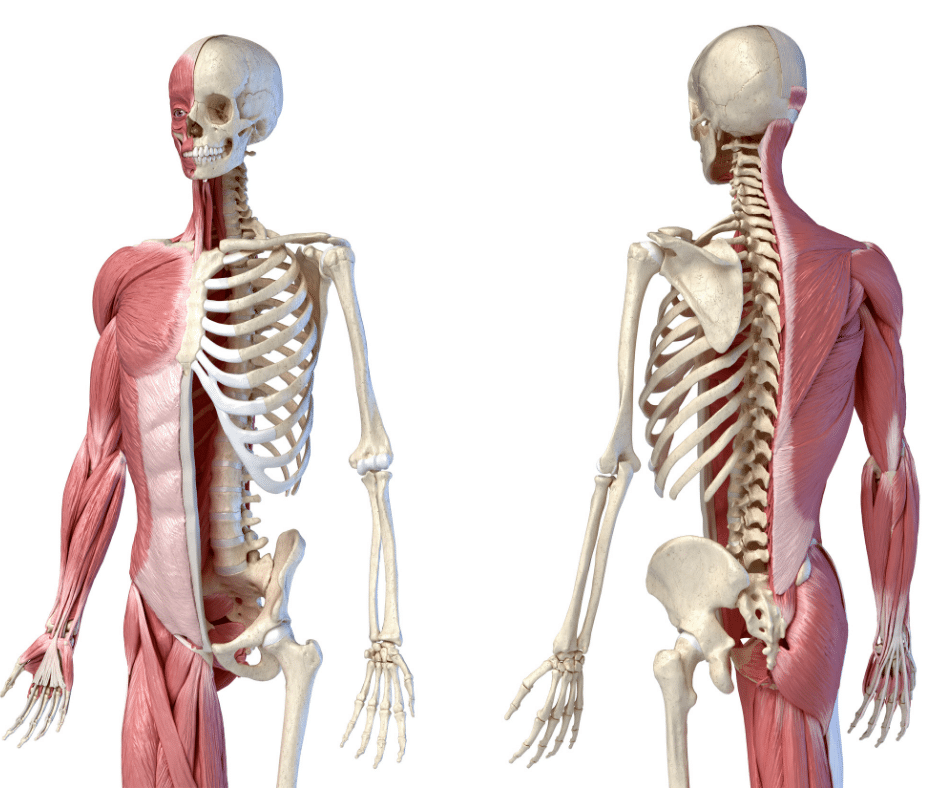
Introduction to the Musculoskeletal System (Anatomy 2)
Lecture: Introduction to the Musculoskeletal System Dear students, Welcome to this asynchronous lecture on the musculoskeletal system. For this lecture you will have the following: Pre-recorded lecture (accompanied by a PowerPoint) to complete in your own time. In-person practical in the anatomy suite. A formative quiz to test your knowledge. You may also want to refresh yourself on how to use some of the anatomy resources that are available to you by following this link: "How to Succeed in Anatomy" Resources Session Introduction This session focuses on studying the gross anatomy of the musculoskeletal system, and will be split into it's two components the skeletal system and the muscular system. Learning outcomes At the end of this session, you will be able to: 1. Describe the anatomical classification of bones and joints. 2. Compare the functional anatomy of the different types of joint. 3. Compare the functional anatomy of skeletal, smooth and cardiac muscle. 4. Compare the functional anatomy of cartilage, tendons and ligaments. 5. Describe the appendicular and axial skeleton. 6. Describe the fascia and muscular compartments of the limbs and their main movements
-
What is the Musculoskeletal System? (1)
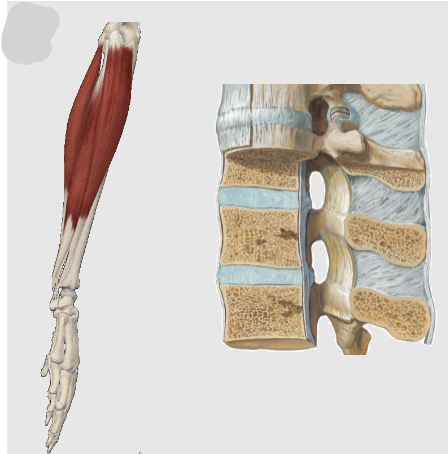
A human body system that provides movement, stability, shape, and support.
-
What are the components of the Musculoskeletal System? (7)
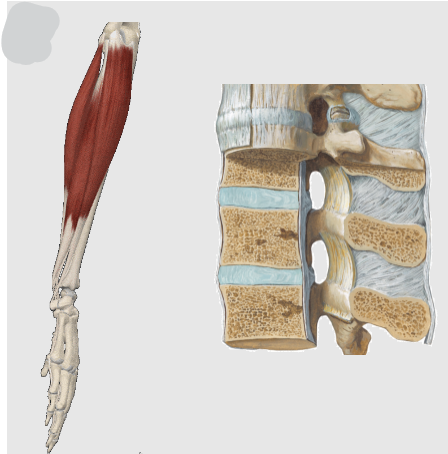
Muscular system
Muscles
Tendons
Skeletal system
Bones
Cartilage
Ligaments
Joints
-
What is the Skeletal System? (1)
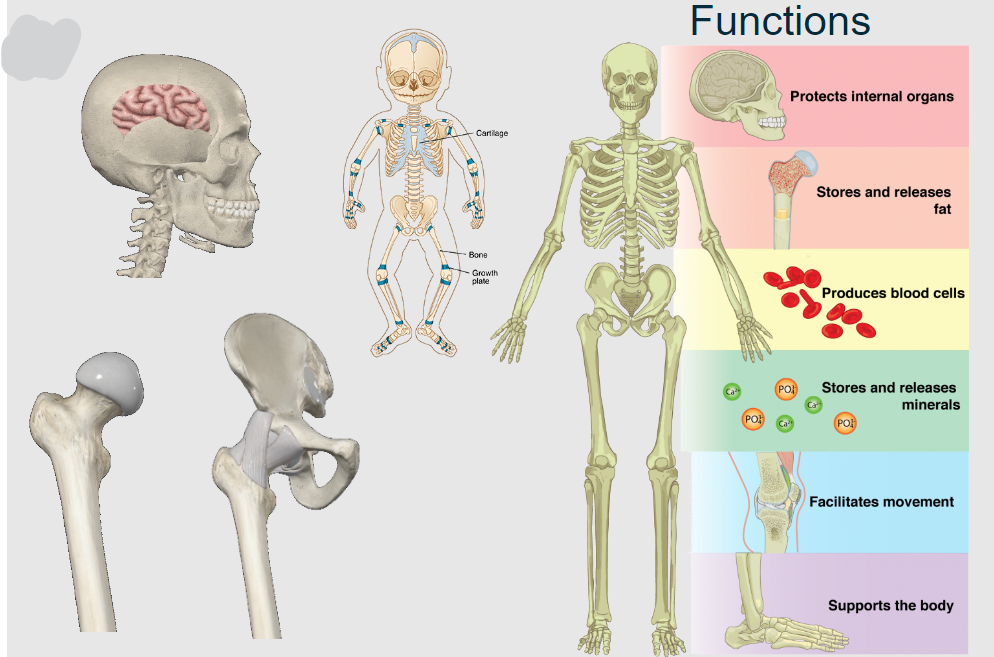
The framework of the body composed of bones, cartilage, and ligaments.
-
What are the functions of the Skeletal System? (5)
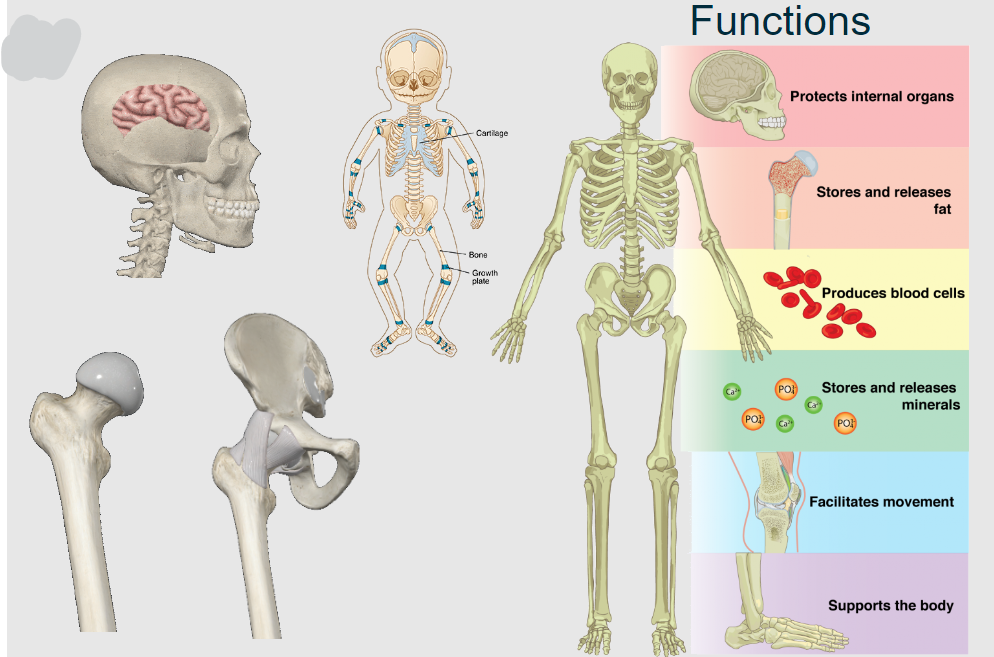
Support/posture
Movement
Protection
Hematopoiesis
Storage
-
What are the bones of the Axial Skeleton? (5)
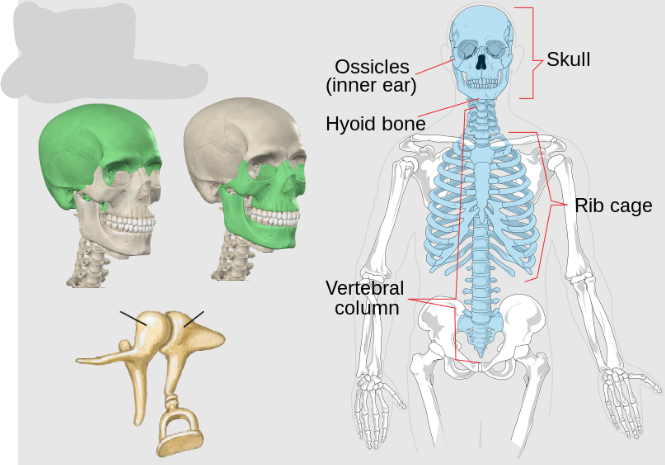
Skull (Neurocranium and viscerocranium)
Ossicles
Hyoid bone
Vertebral column (Cervical (7), Thoracic (12), Lumbar (5), Sacrum (5 fused), Coccyx (4 fused))
Thorax (Ribs, Sternum)
-
What are the bones of the Appendicular Skeleton? (1)
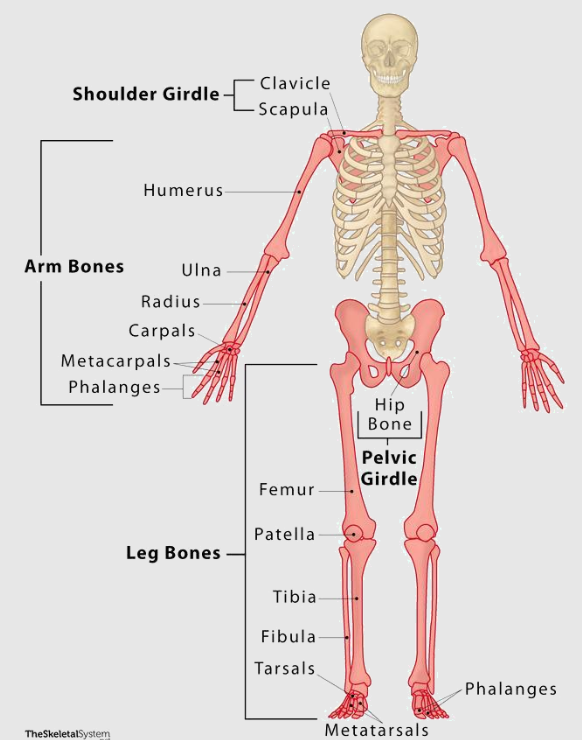
Bones of the limb girdles and limbs.
-
What bones make up the Upper Limb? (6)
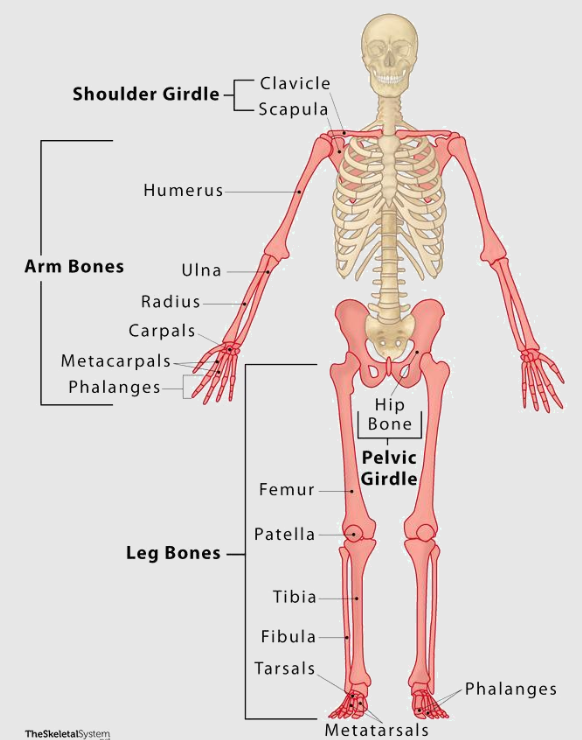
Shoulder girdle: clavicle & scapula
Arm: humerus
Forearm: radius & ulna
Wrist: carpals
Hand: metacarpals & phalanges
-
What bones make up the Lower Limb? (6)
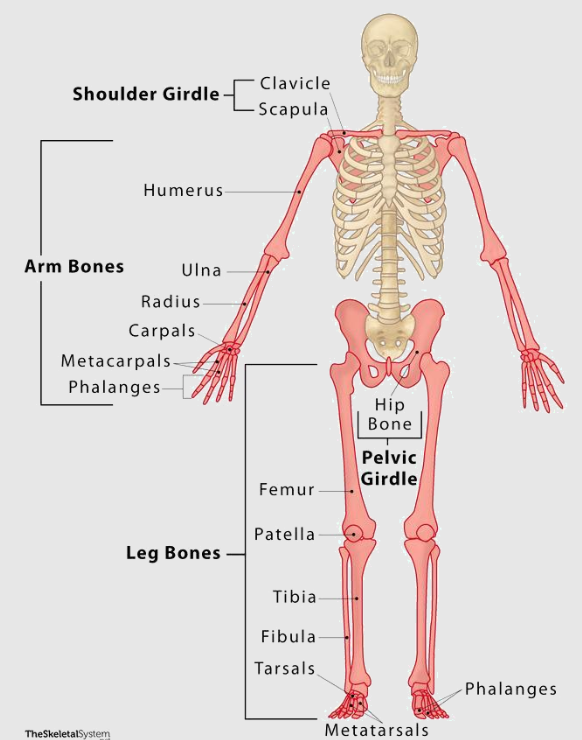
Pelvic girdle: ilium, ischium, pubis
Thigh: femur and patella
Leg: tibia & fibula
Ankle: tarsals
Foot: metatarsals & phalanges
-
What are the five groups of bones classified by shape? (5)
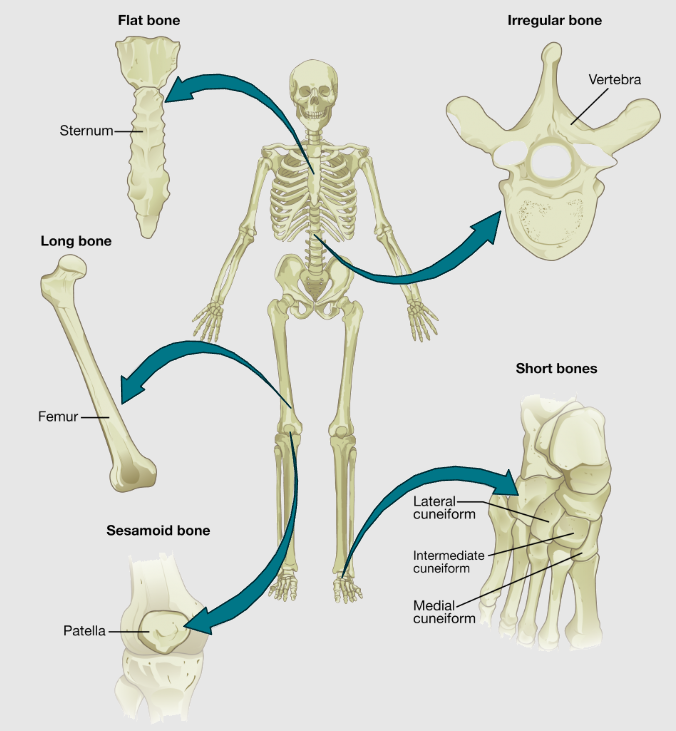
Flat
Long
Short
Irregular
Sesamoid
-
Describe Flat bones and their function. (2)
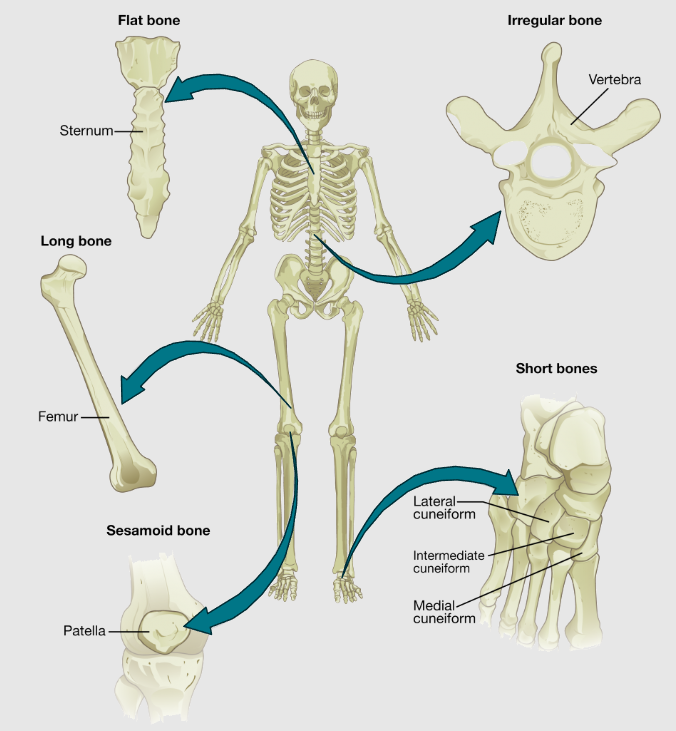
Flat bones:
Protect vital organs
-
Describe Long bones and their function. (2)
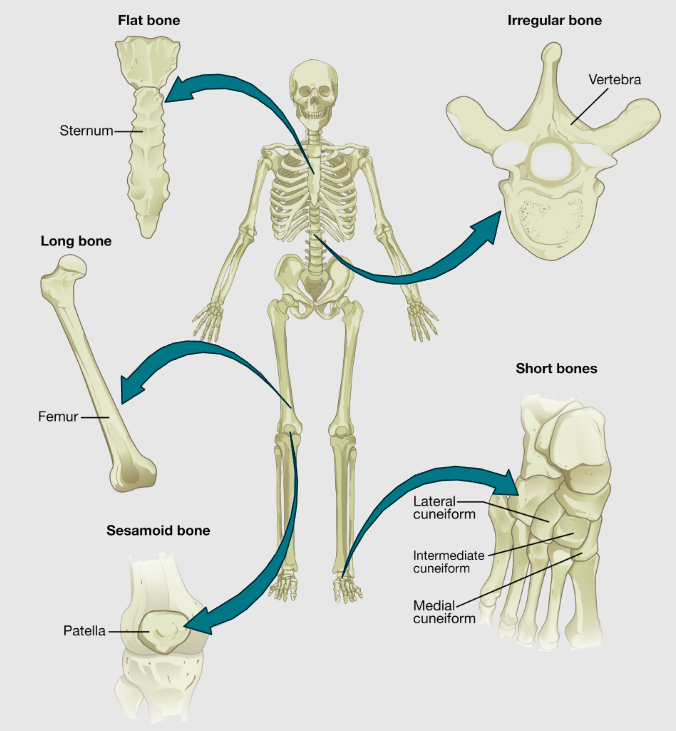
Long bones:
Facilitate movement
-
Describe Short bones and their function. (2)
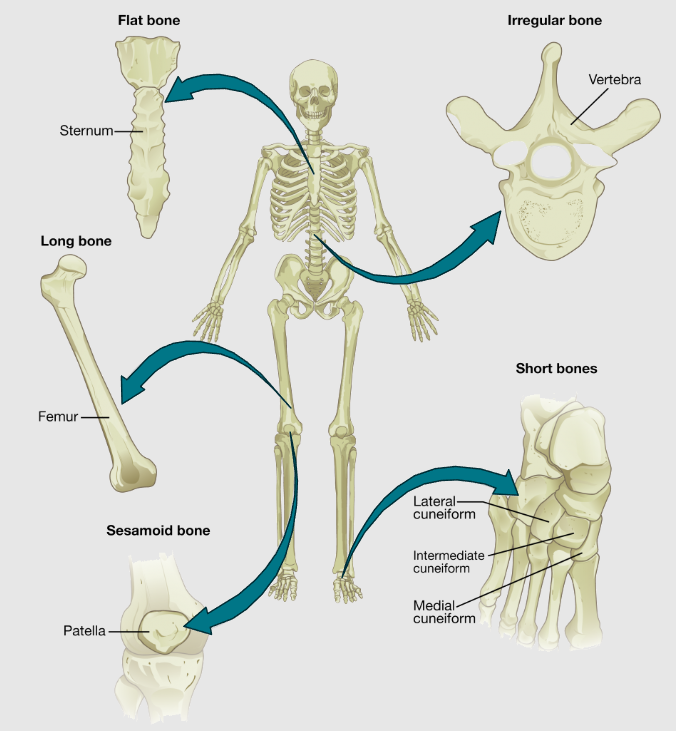
Short bones:
Provide stability and support
-
Describe Irregular bones and their function. (2)
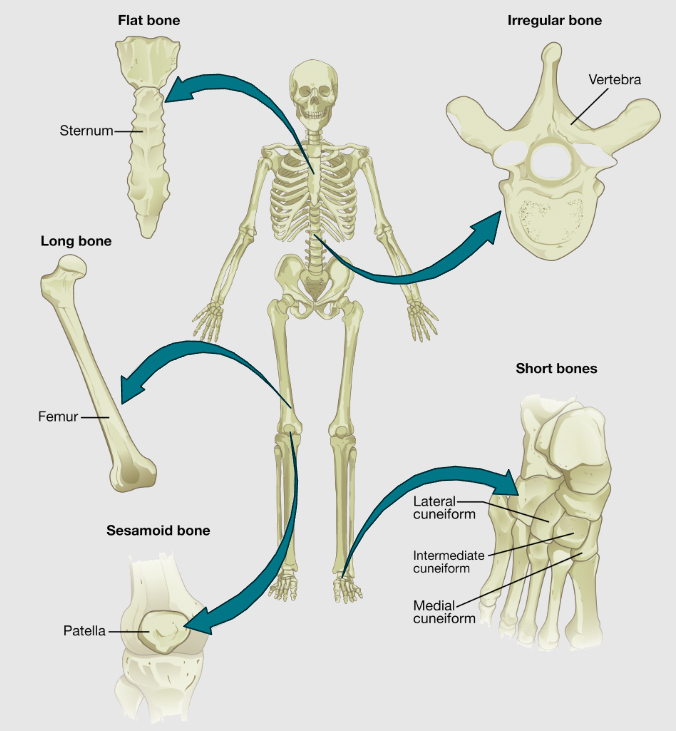
Irregular bones:
Provide protection
Facilitate movement
-
Describe Sesamoid bones and their function. (2)
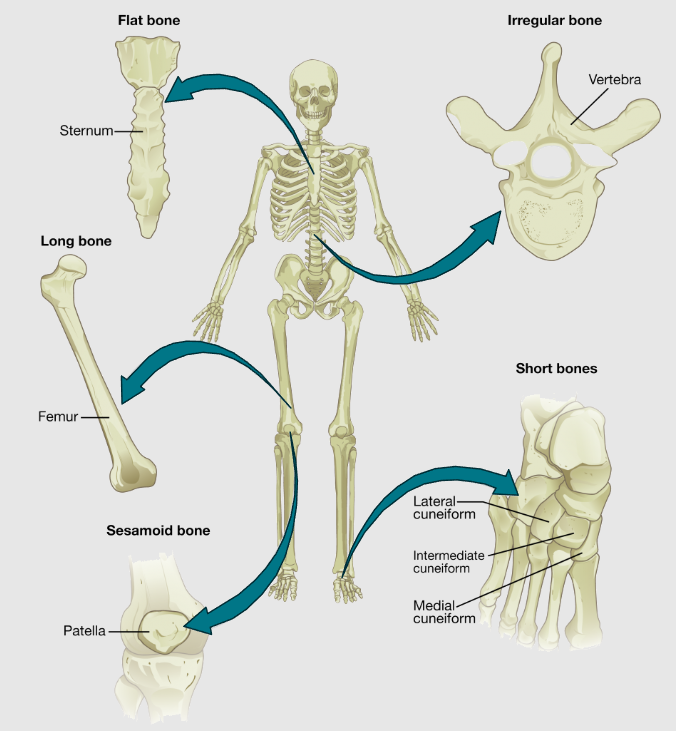
Sesamoid bones:
Protect tendons
Provide leverage
-
What are the types of joints classified by tissue? (3)
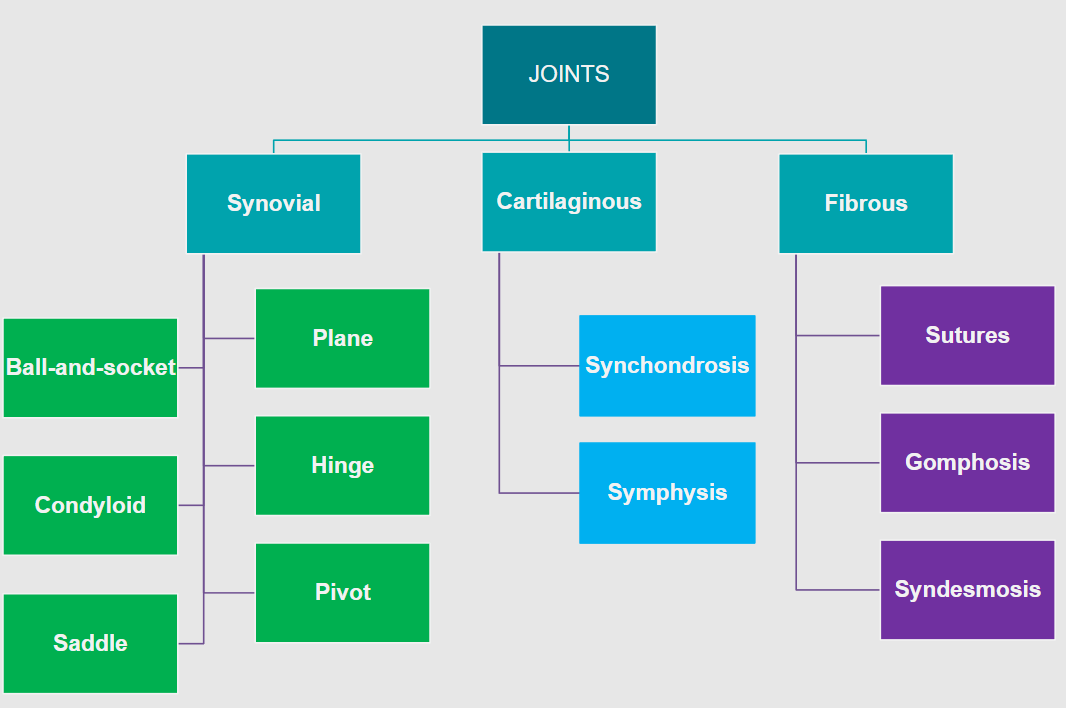
Fibrous Joints: Bones connected by fibrous tissue
Cartilaginous Joints: Bones connected by cartilage
Synovial Joints: Articulating surfaces enclosed within a fluid-filled joint capsule
-
What are Fibrous Joints (3), and what are their types? (2 marks for each)
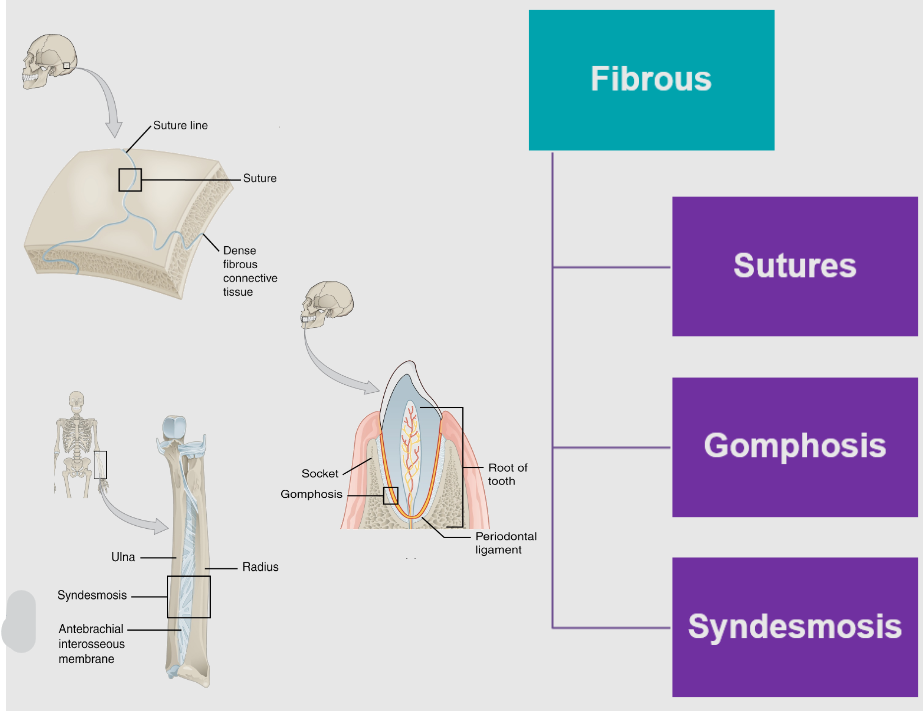
Fibrous Joints: Composed of tough fibrous tissue, providing strength and stability over mobility.
Sutures:
Immovable joints (Synarthrosis)
Found only between skull bones
Gomphoses:
Immovable joints
Attach teeth to maxilla
Syndesmoses:
Slightly movable (Amphiarthroses)
Example: Interosseous membrane between bones
-
What are Cartilaginous Joints, and what are their types? (2)
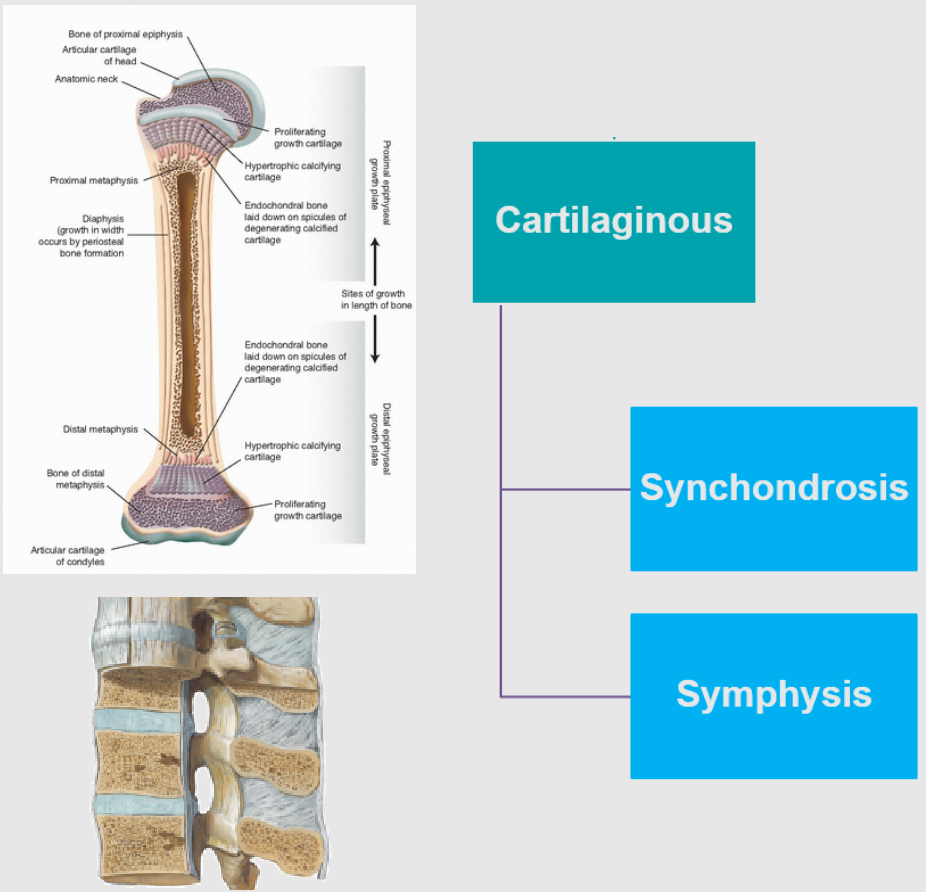
Cartilaginous Joints: Bones connected by cartilage, providing either immobility or slight movement.
Synchondroses (Primary Cartilaginous):
Made of hyaline cartilage
Immovable (synarthrosis)
Example: Epiphyseal plates (growth plates)
Symphyses (Secondary Cartilaginous):
Composed of fibrocartilage
Slightly movable (amphiarthrosis)
Example: Intervertebral discs
-
What are Synovial Joints? (3)
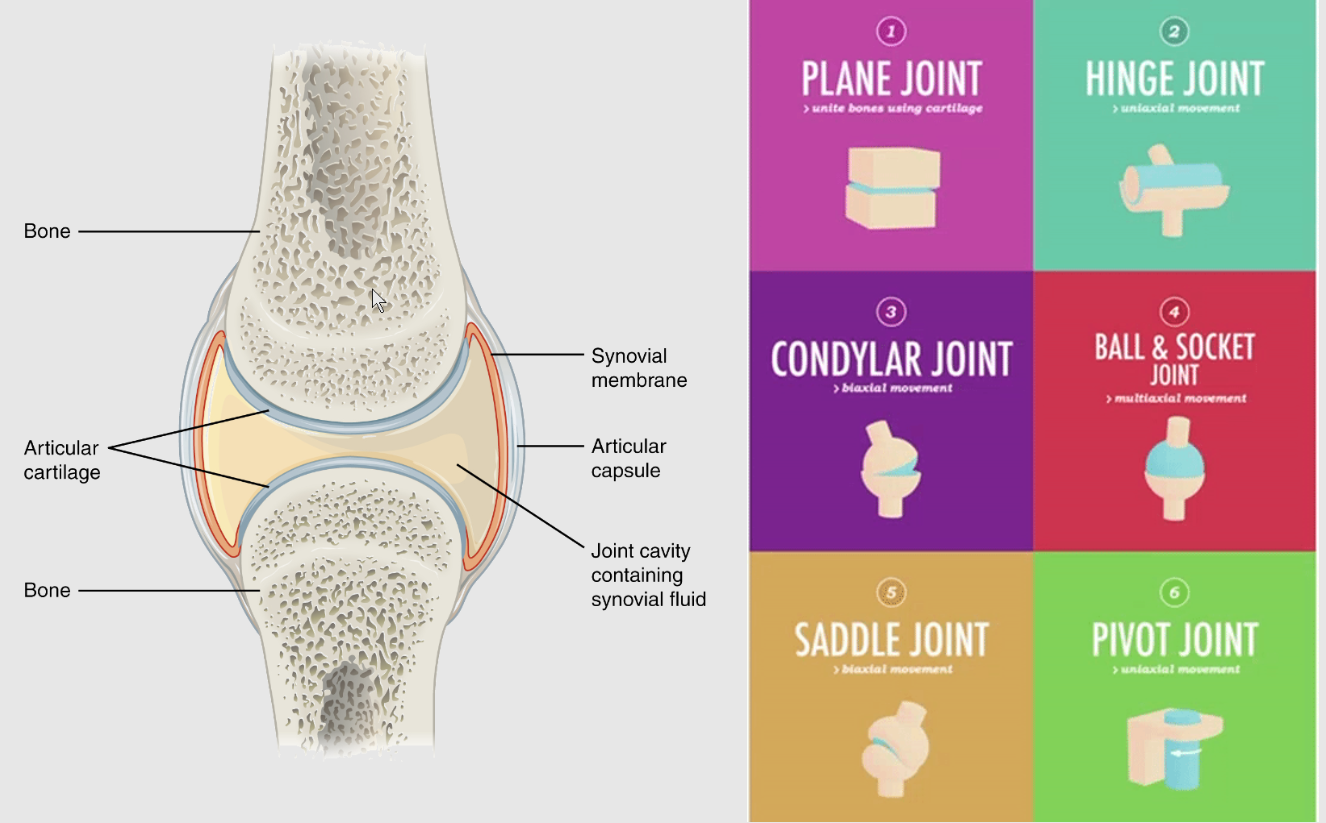
Joints that contain a joint cavity.
Enclosed within a fluid-filled capsule.
Surrounded by articular cartilage.
-
What are the components of Synovial Joints? (3)
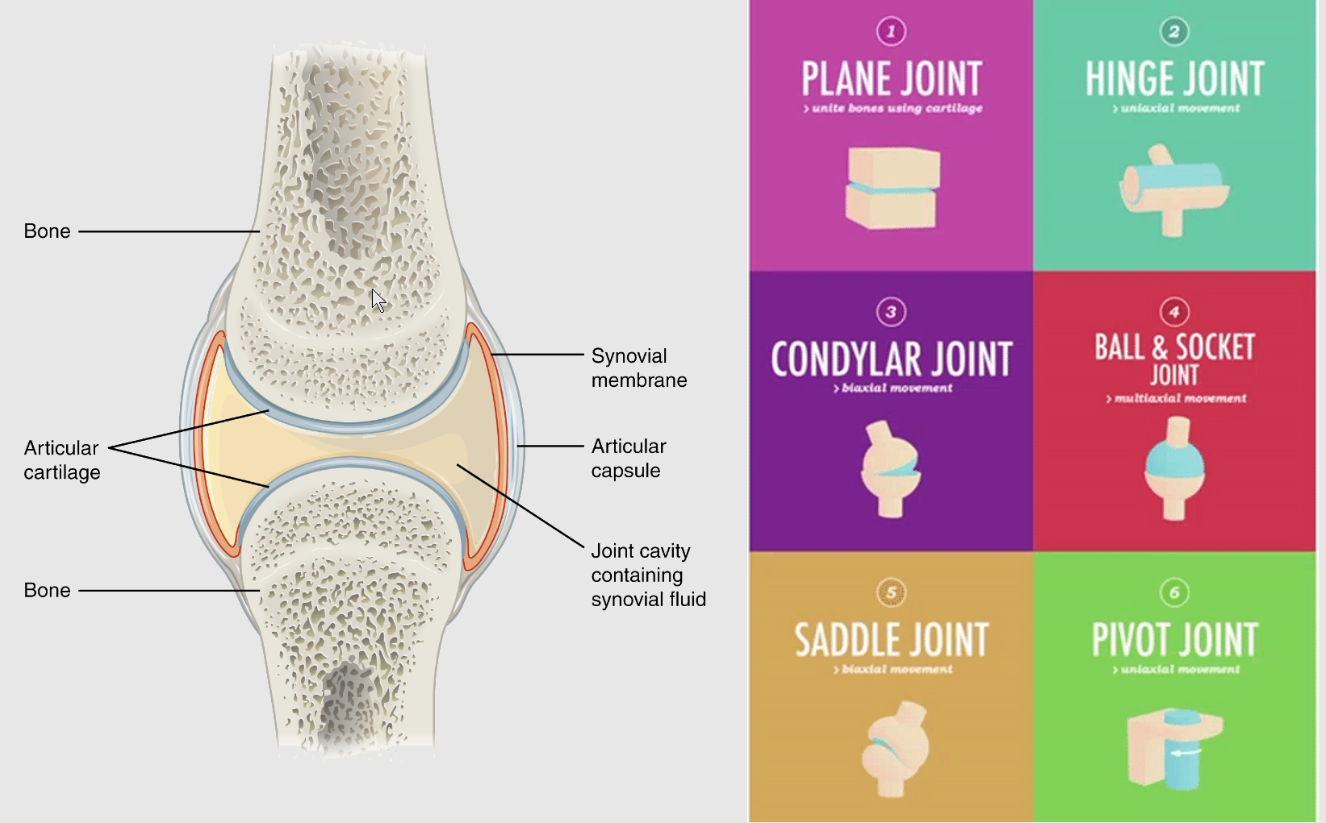
Joint Cavity: Space that contains synovial fluid.
Synovial Fluid: Lubricates the joint and reduces friction.
Articular Cartilage: Covers the articulating surfaces of the bones.
-
What are the six types of Synovial Joints? (6)
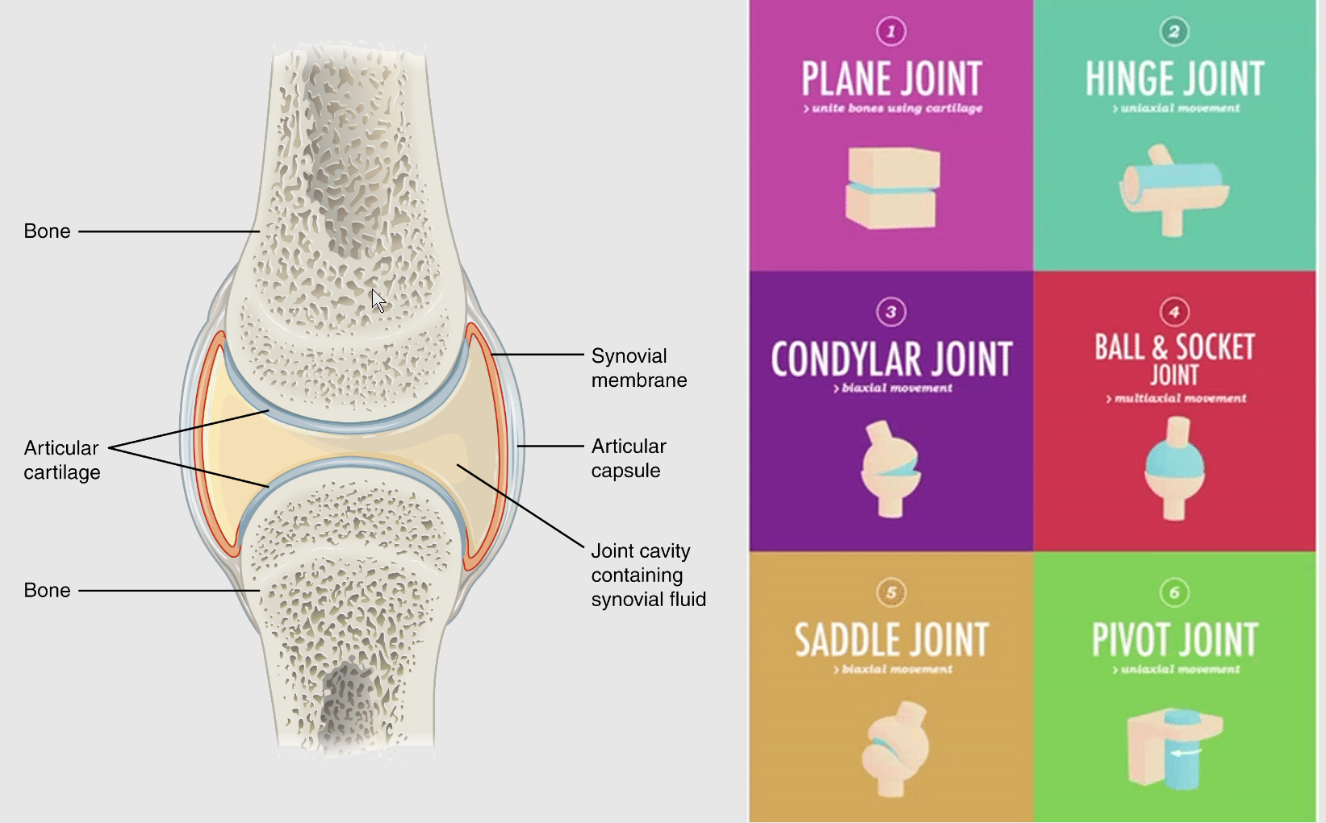
Plane Joints: Allow gliding movements.
Hinge Joints: Allow movement in one plane (flexion/extension).
Condyloid Joints: Allow movement in two planes (flexion/extension, abduction/adduction).
Ball & Socket Joints: Allow movement in multiple planes (flexion/extension, abduction/adduction, rotation).
Saddle Joints: Allow movement in two planes with a greater range of motion than hinge joints.
Pivot Joints: Allow rotational movement around a single axis.
-
What are the functions of cartilage? (3)
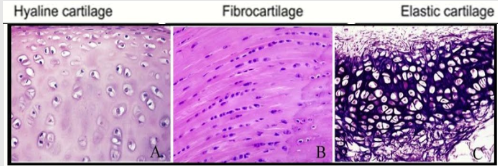
Support/posture
Articular surfaces
Template for skeleton
-
What are the three types of cartilage? (3)
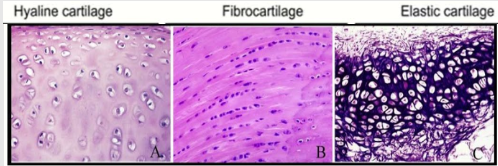
Hyaline cartilage
Fibrocartilage
Elastic cartilage
-
What are the characteristics of elastic cartilage? (2) Give an example (1)
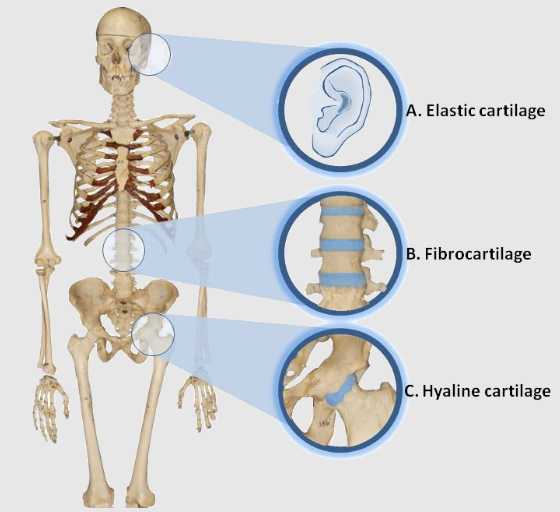
Abundance of elastic fibres
Resilient and flexible
Example: Outer ear
-
What are the characteristics of fibrocartilage? (2) Give an example (1)
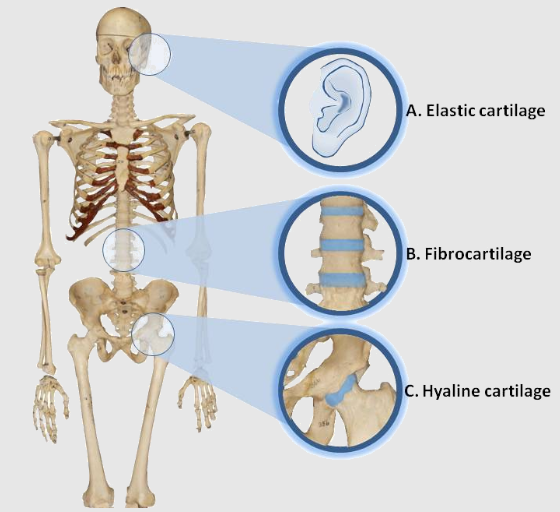
Strongest type of cartilage
Usually attached to hyaline cartilage, tendons, or ligaments
Example: Intervertebral discs
-
What are the characteristics of hyaline cartilage? (2) Give an example (1)
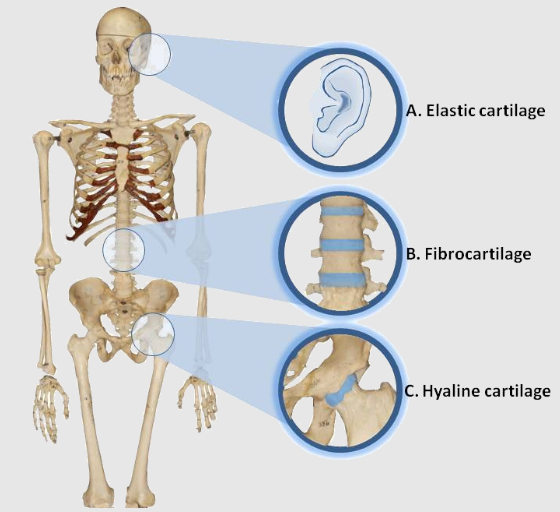
Most common type of cartilage
Found in epiphyseal growth plates
Articular cartilage example: Head of femur
-
What are the functions of ligaments? (3)
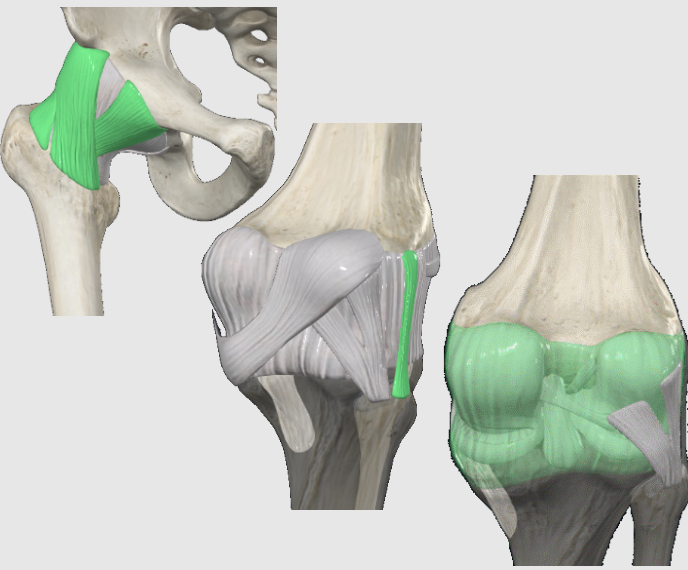
Stabilize joints and limit movement
Increase muscle attachment area
Hold tendons down
-
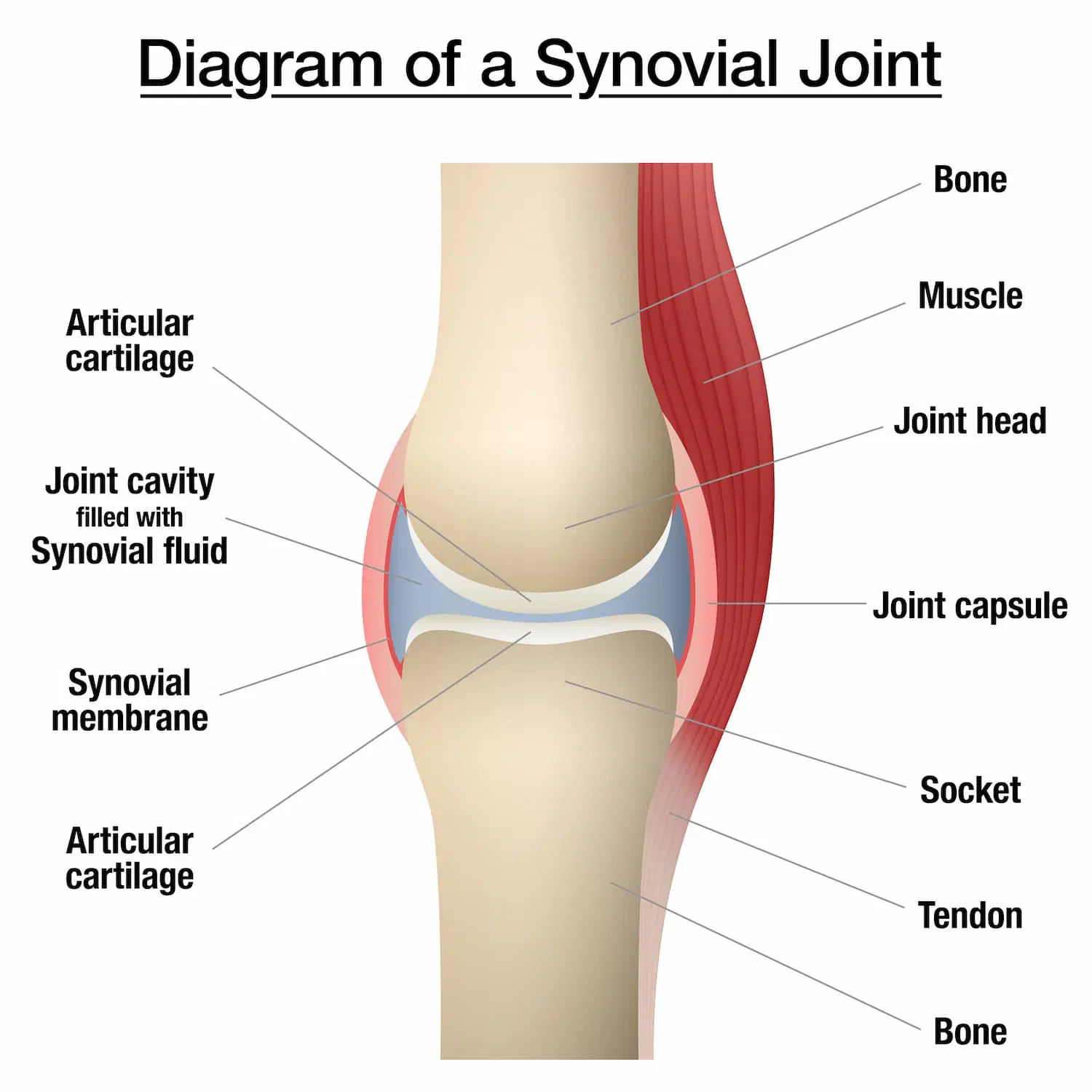
What are the types of ligaments? (3)
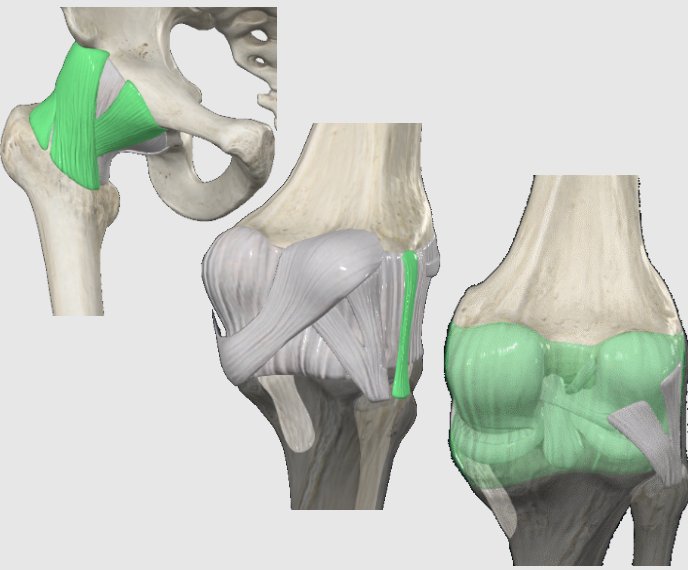
Capsular ligaments
Extracapsular ligaments
Intracapsular ligaments
-
What do articulation ligaments connect? (1)
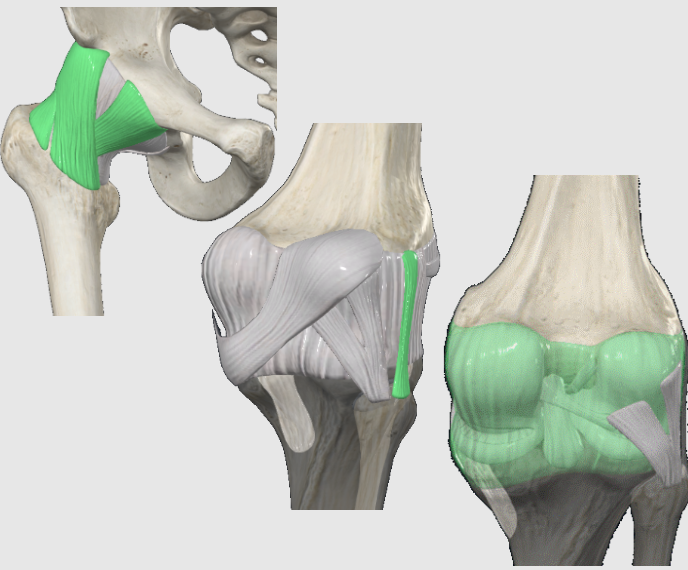
Bone to bone
-
What are the components of the muscular system? (3)
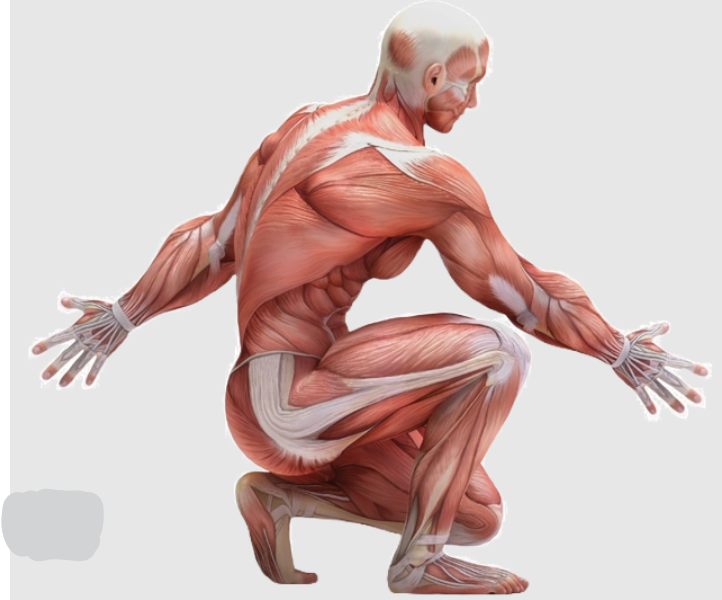
Muscles
Tendons
-
How can muscles be classified? (5)
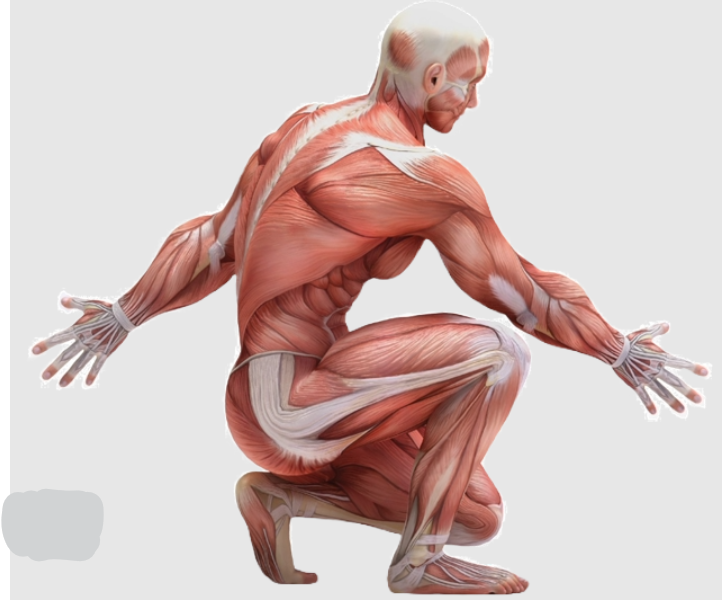
Microstructure
Orientation of the muscle fibers
Action
Shape
Position in the body
Number of heads (proximal attachments)
-
Picture demonstrating Muscle Classification: Microstructure:
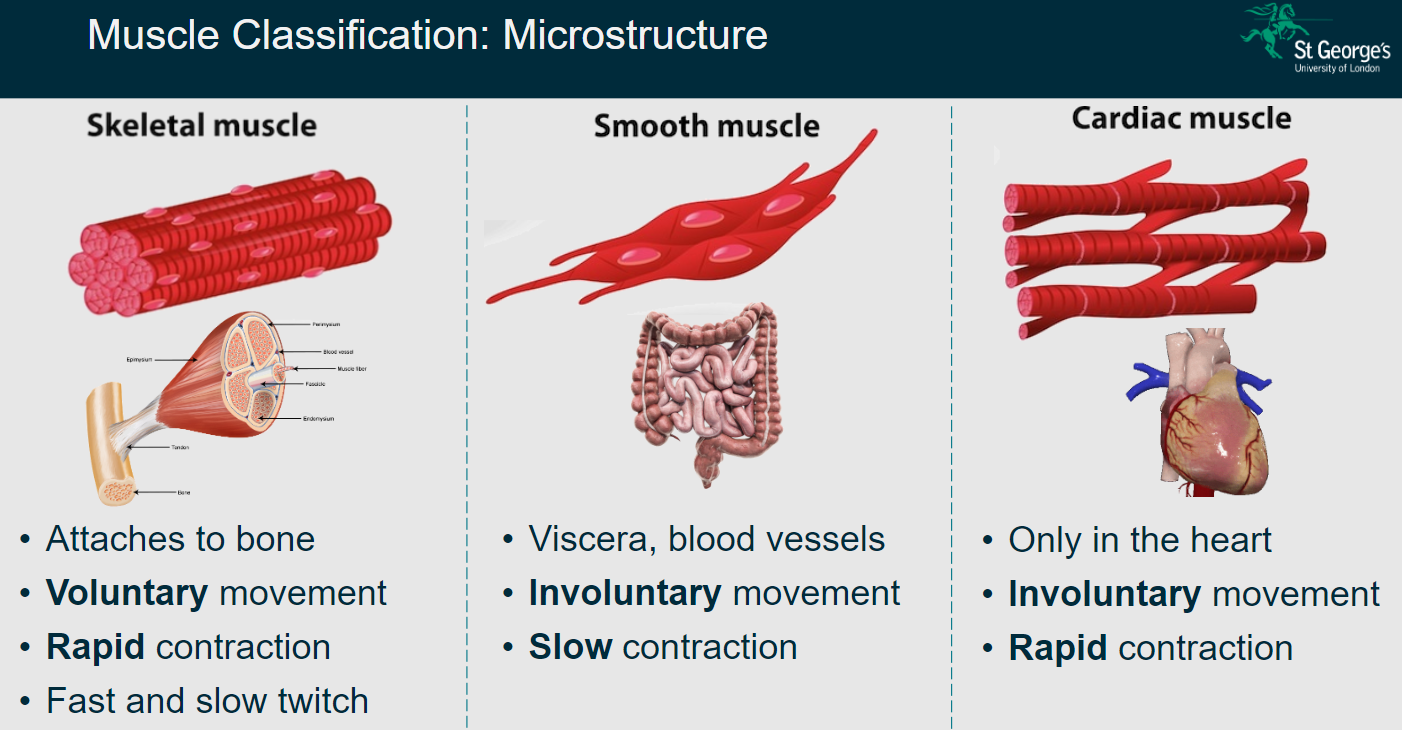
-
What are the characteristics of skeletal muscle? (4)
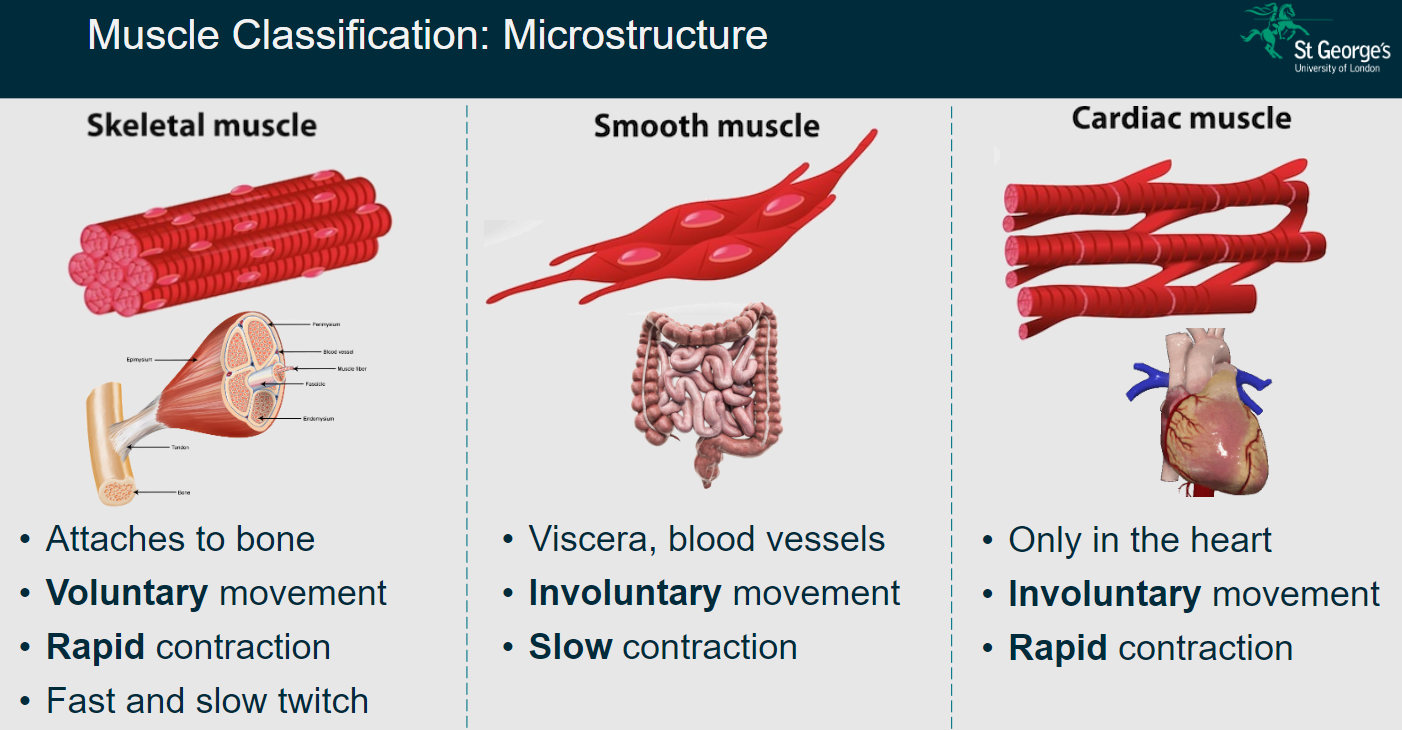
Attaches to bone
Allows voluntary movement
Rapid contraction
Contains fast and slow twitch fibers
-
What are the characteristics of smooth muscle? (3)
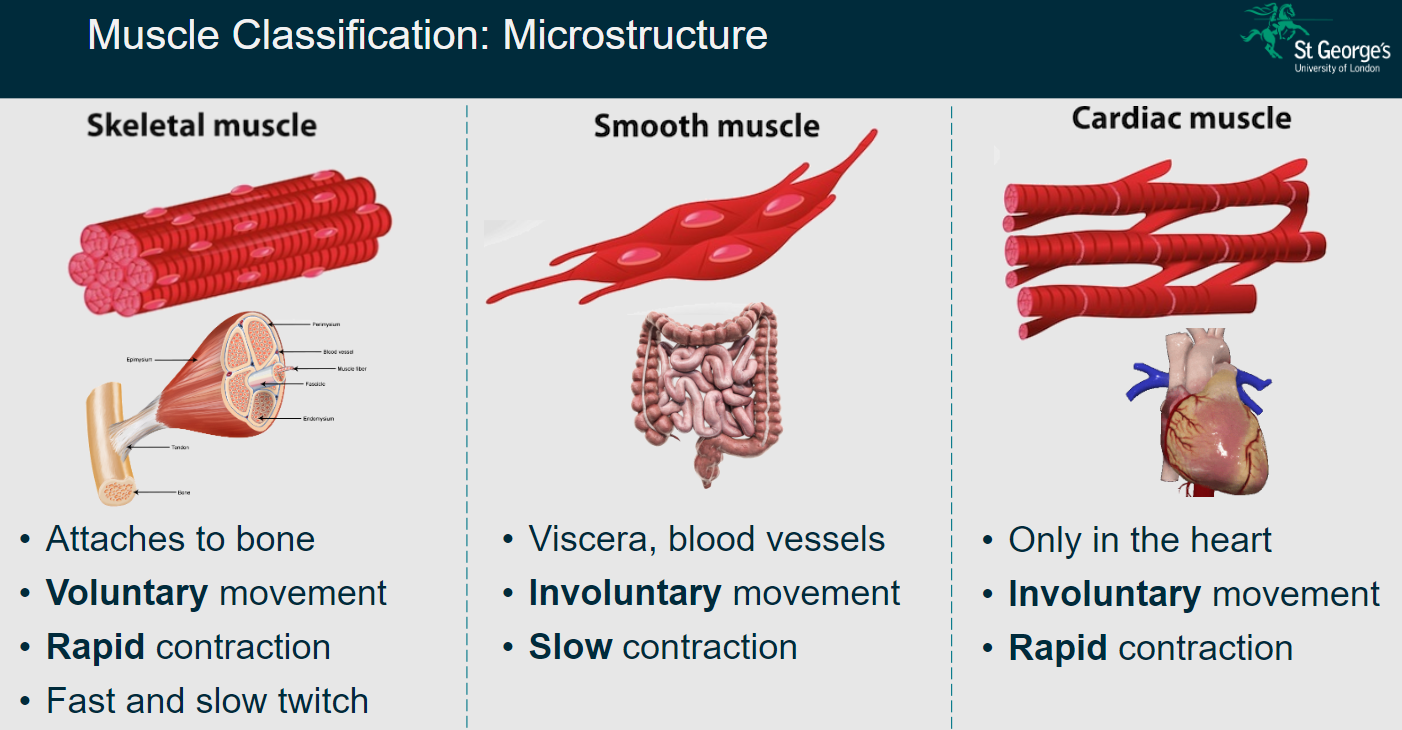
Found in viscera and blood vessels
Allows involuntary movement
Exhibits slow contraction
-
What are the characteristics of cardiac muscle? (3)
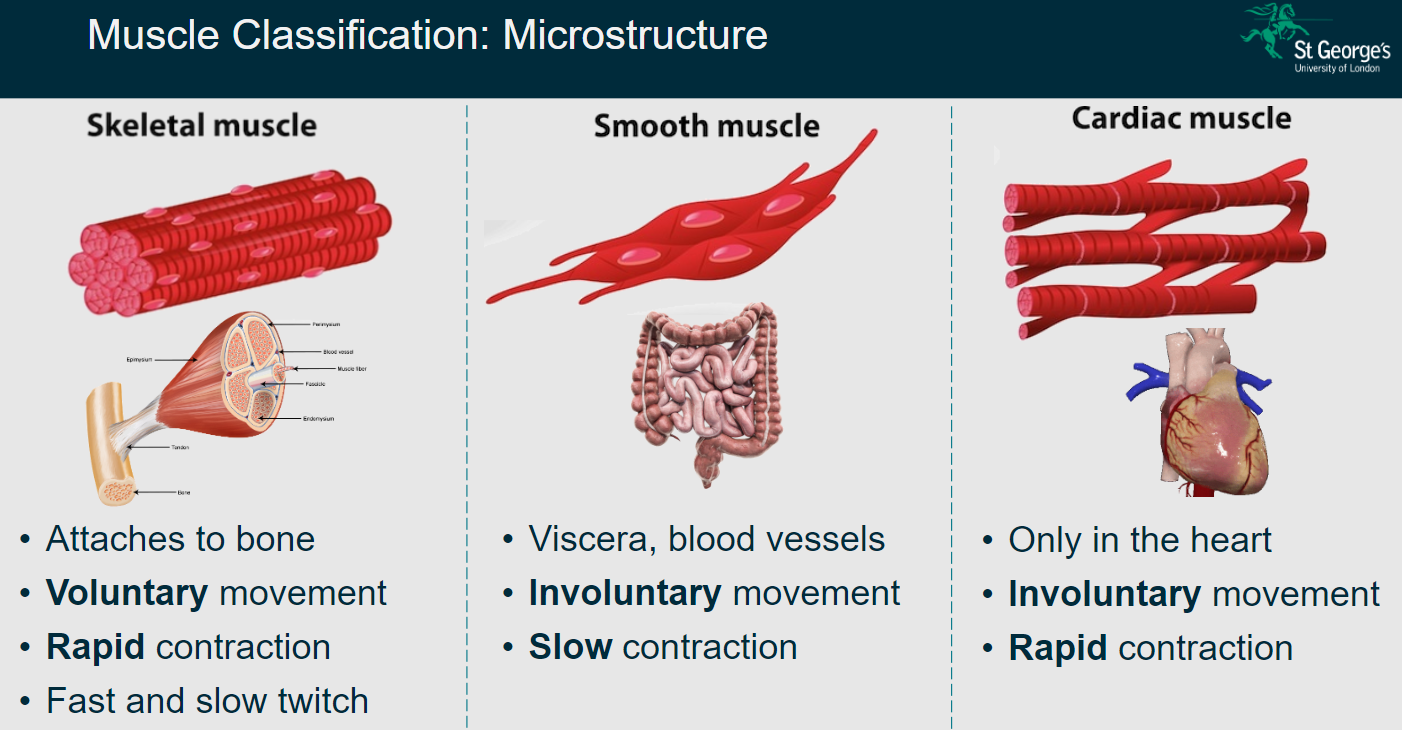
Present only in the heart
Allows involuntary movement
Exhibits rapid contraction
-
What are the types of muscle orientation? (4)
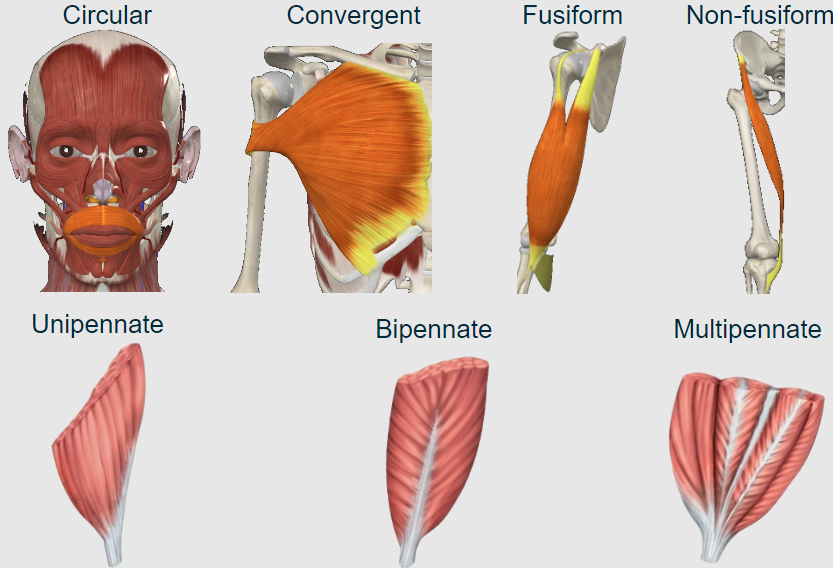
Circular
Convergent
Parallel
Fusiform
-
What are the types of non-fusiform muscle? (3)
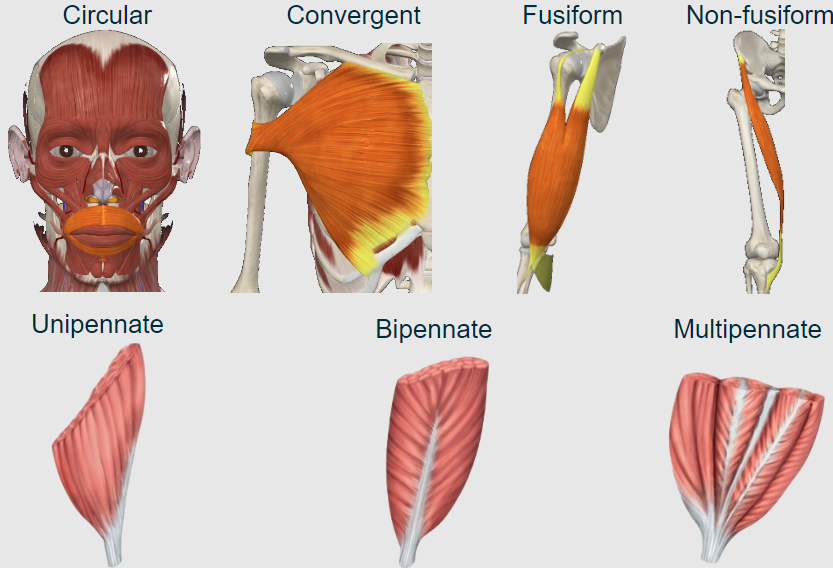
Pennate
Unipennate
Bipennate
Multipennate
-
What is fascia and its function? (4)
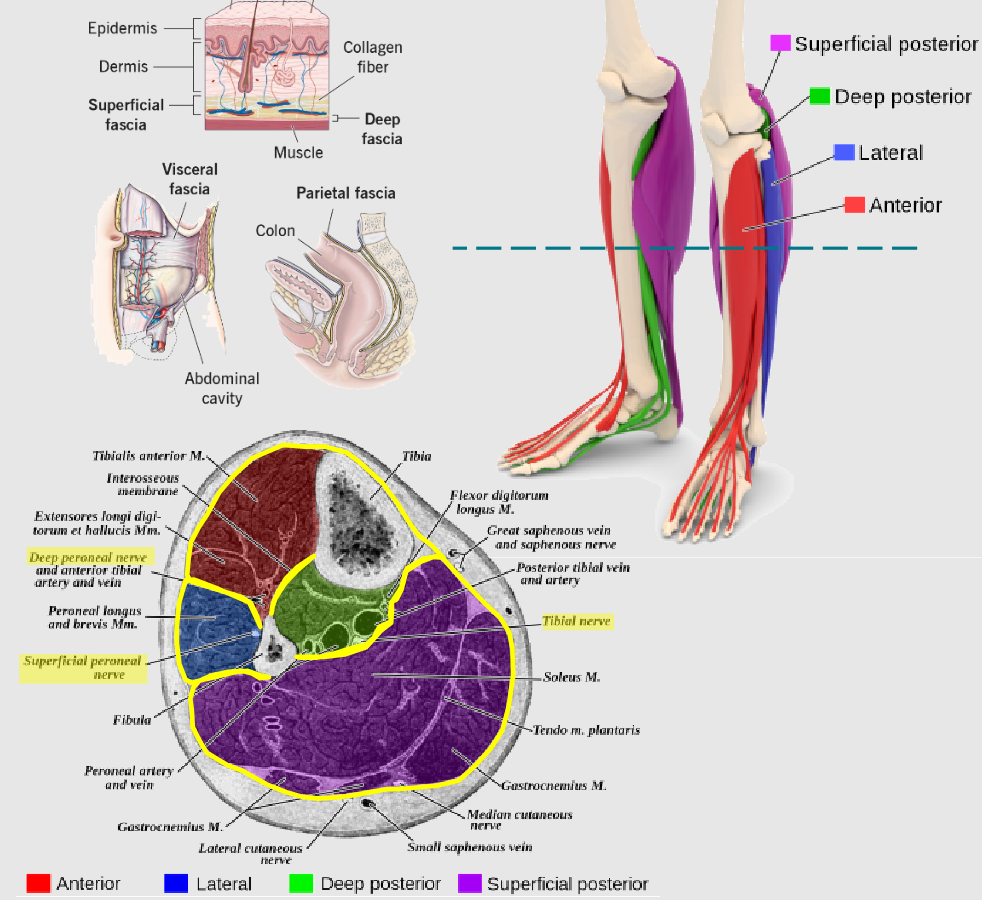
Thin connective tissue
Surrounds muscles, organs, blood vessels, and nerves.
Provides structure and support throughout the body.
Provides a smooth surface for structures to slide against each other without friction.
-
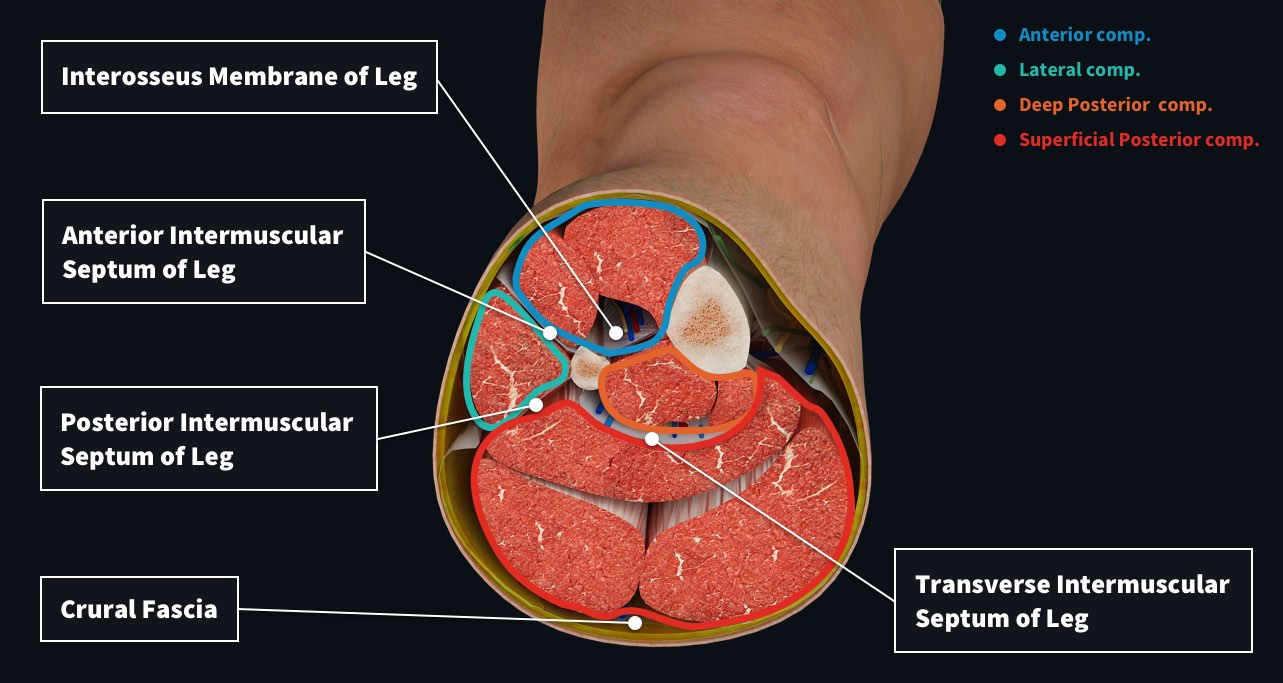
What defines a muscle compartment? (4)
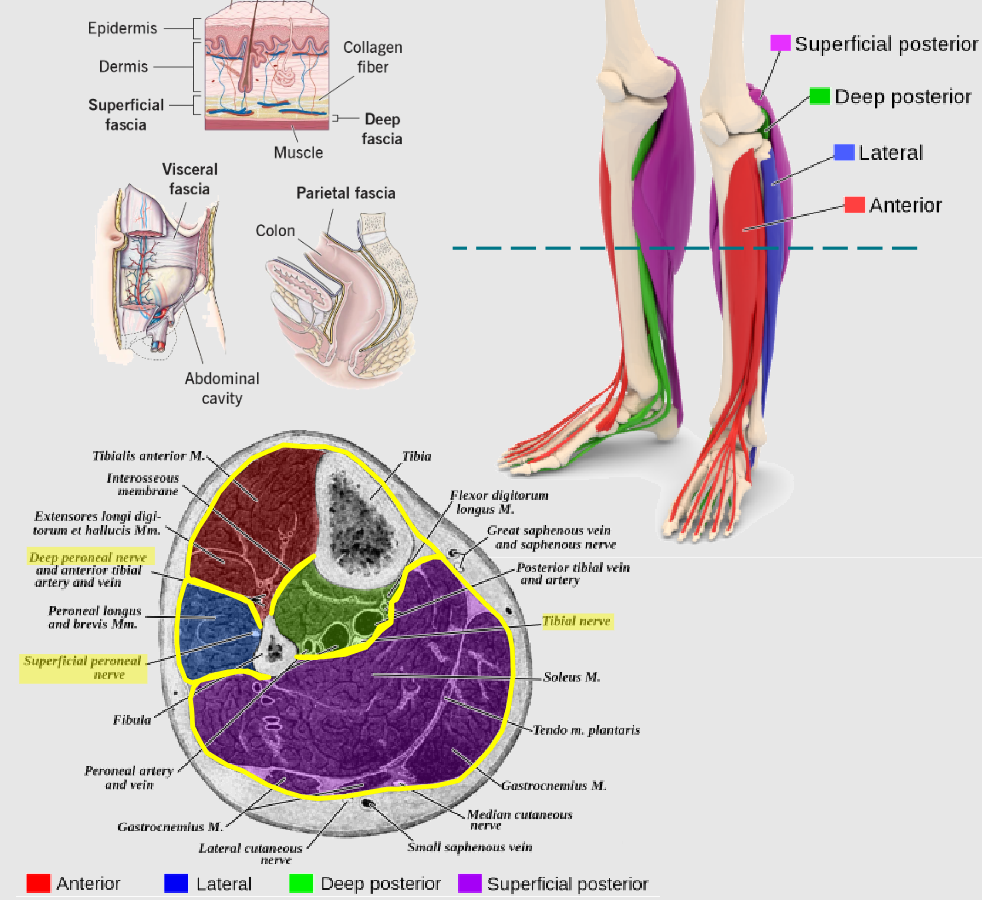
Muscles and nerves wrapped in deep fascia.
Separated by intermuscular septa (fibrous connective tissue).
Usually supplied by the same nerve and artery.
Usually have similar functions.
-
What are the actions and innervation of the anterior arm? (3)
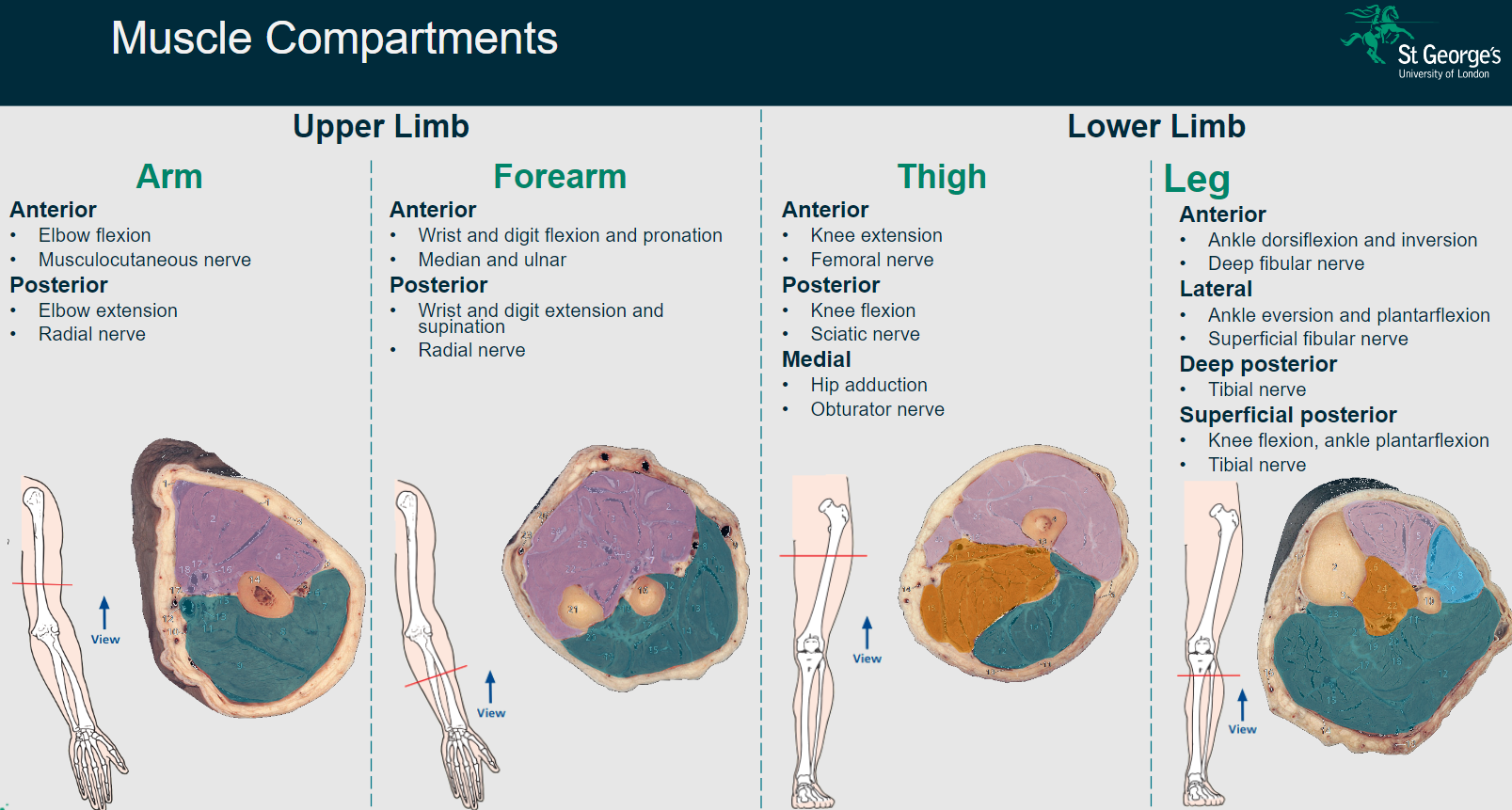
Elbow flexion
Innervated by the musculocutaneous nerve.
-
What are the actions and innervation of the posterior arm? (2)
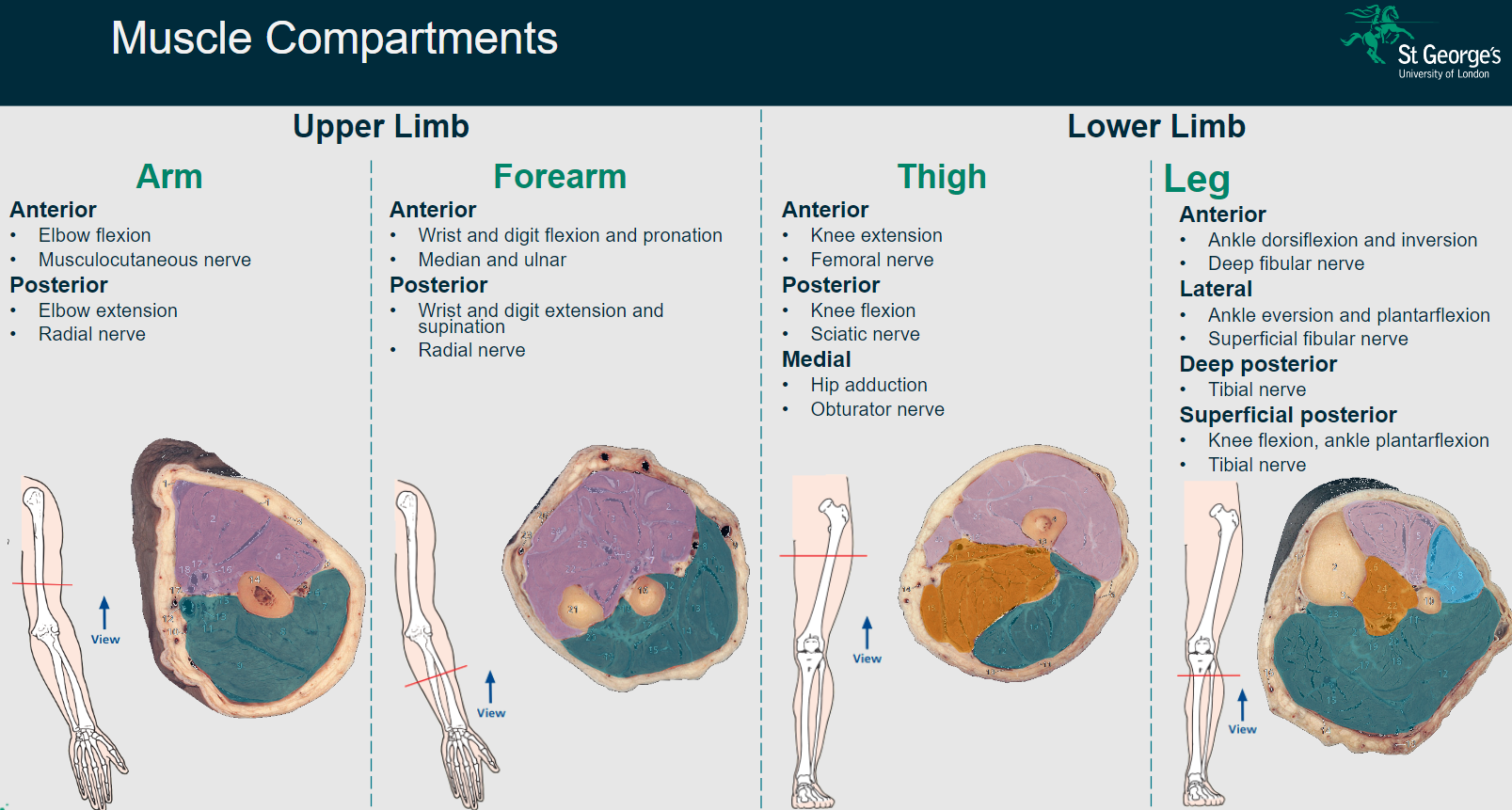
Elbow extension
Innervated by the radial nerve.
-
What are the actions and innervation of the anterior leg? (3)
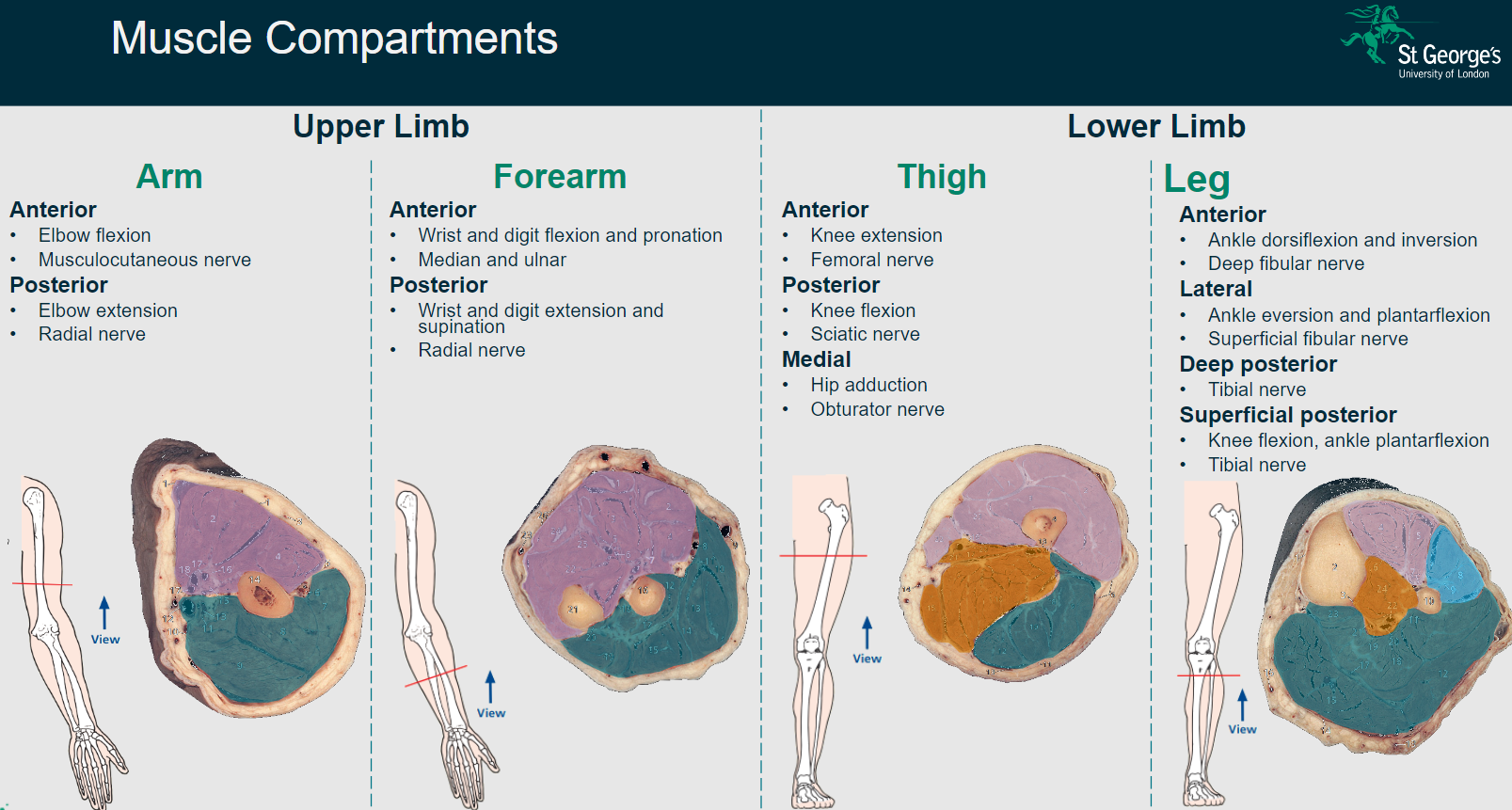
Ankle dorsiflexion and inversion
Innervated by the deep fibular nerve.
-
What are the actions and innervation of the lateral leg? (3)
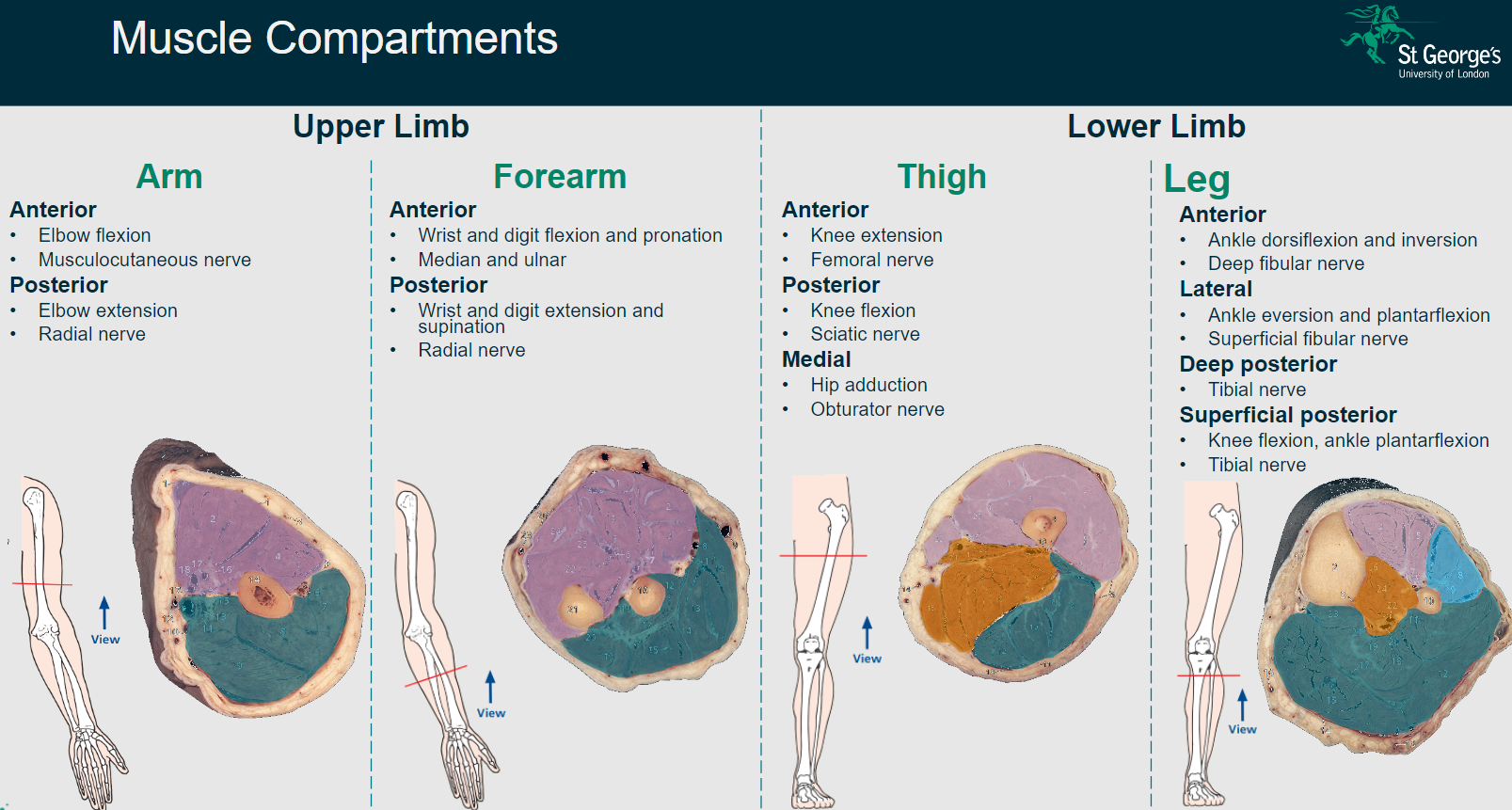
Ankle eversion and plantar flexion
Innervated by the superficial fibular nerve.
-
What are the actions and innervation of the deep posterior leg? (2)
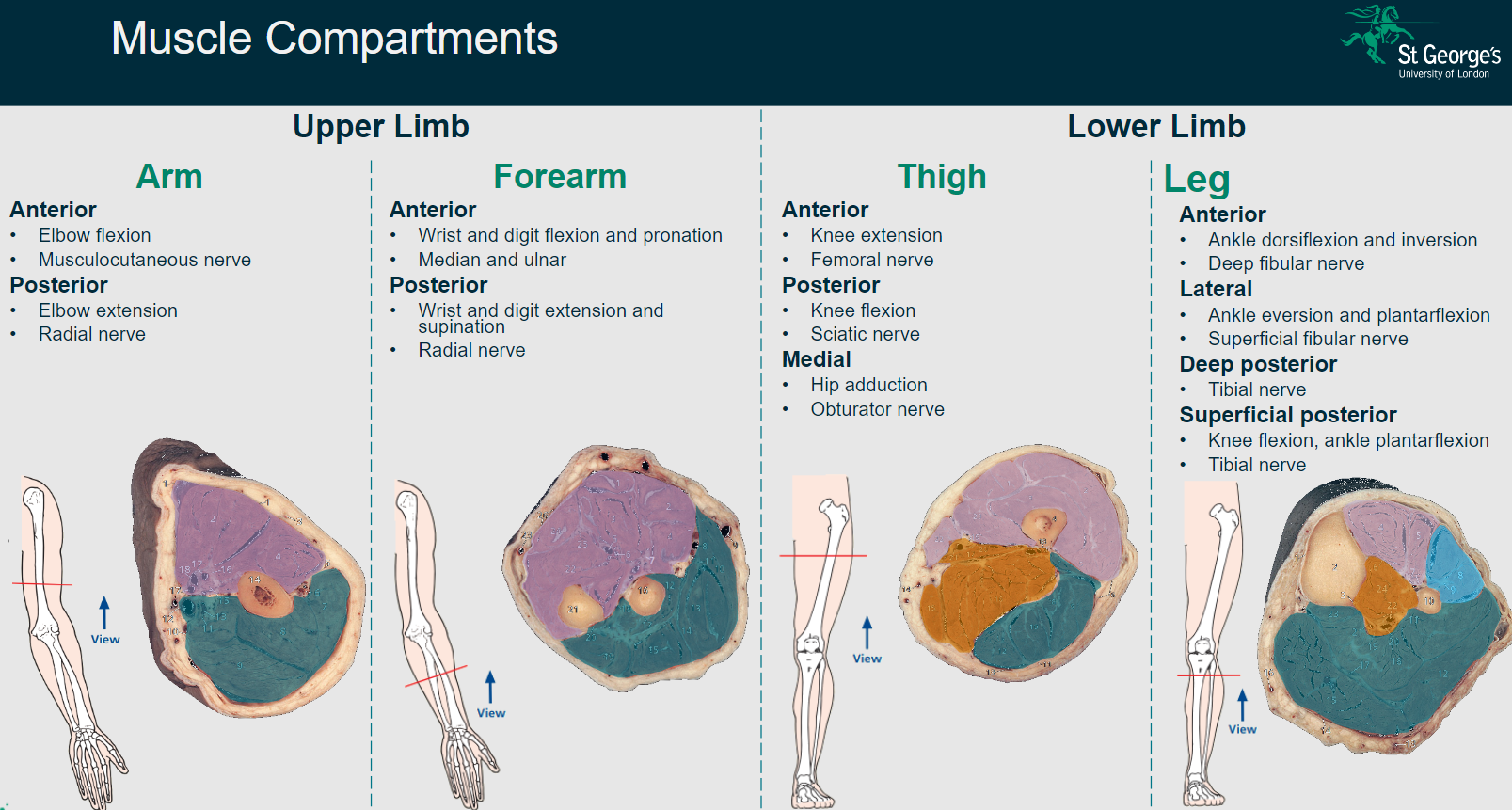
Innervated by the tibial nerve.
-
What are the actions and innervation of the superficial posterior leg? (3)
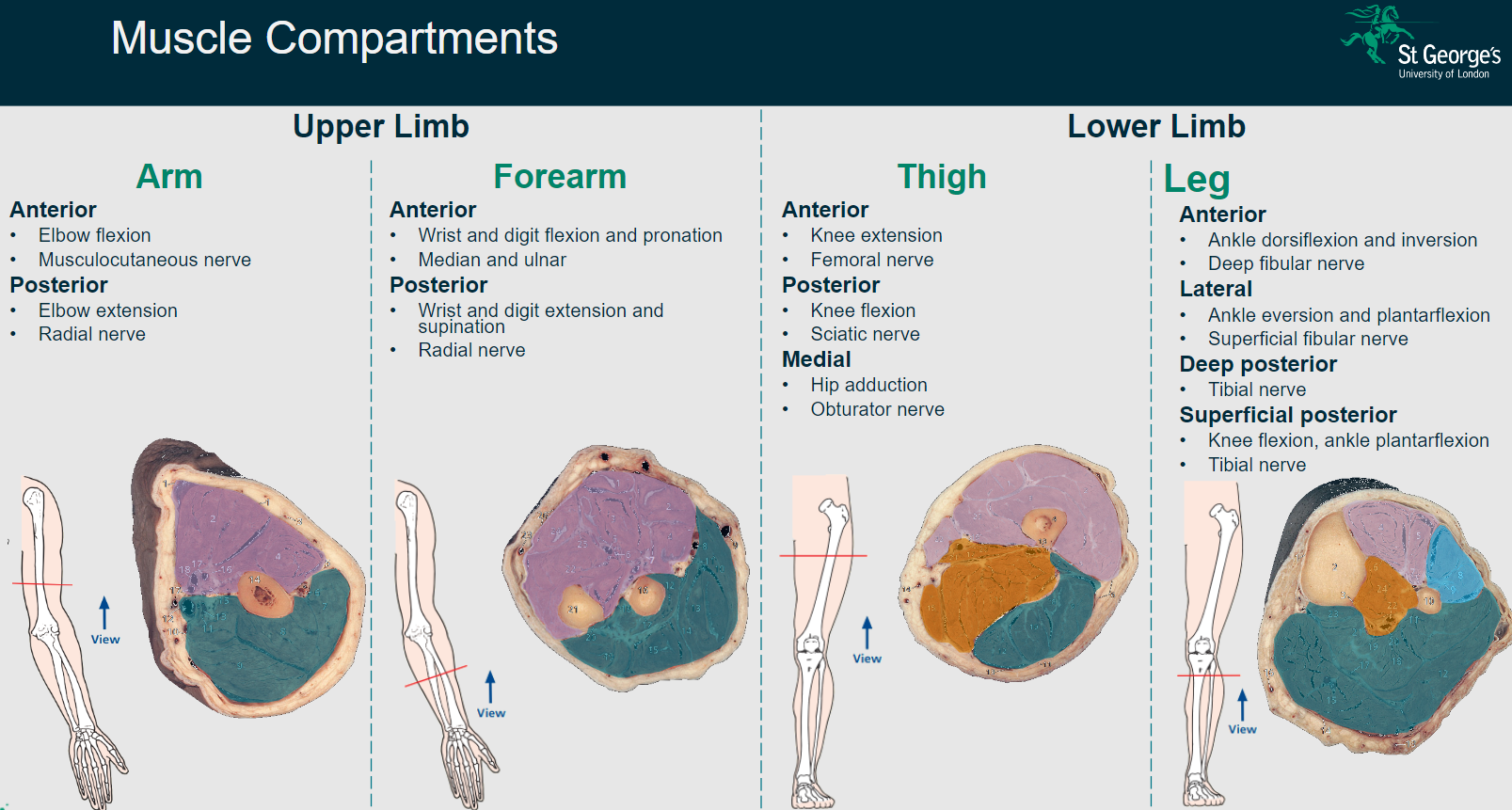
Knee flexion, ankle plantarflexion
Innervated by the tibial nerve.
-
What are the actions and innervation of the anterior forearm? (3)
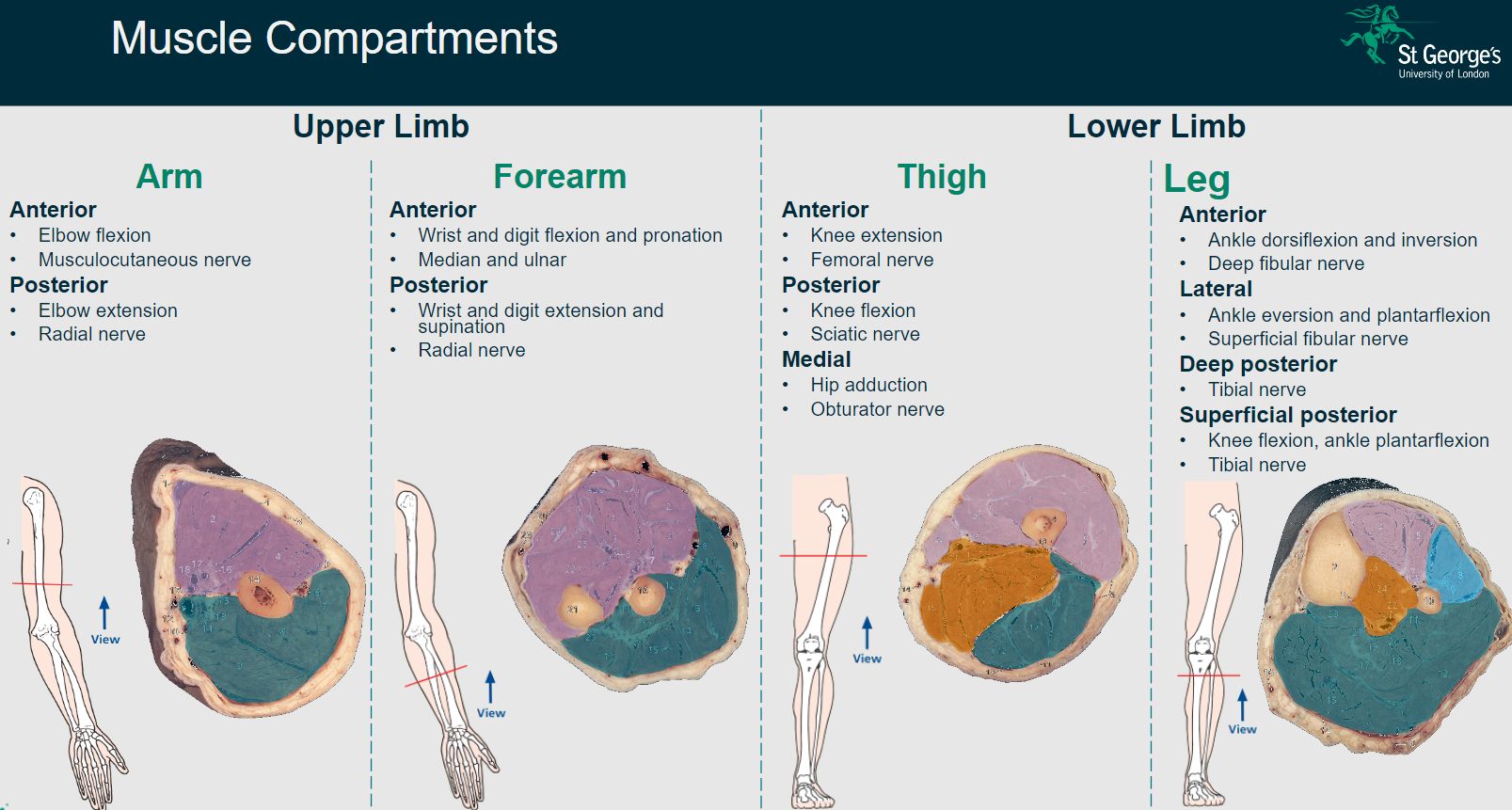
Wrist and digit flexion and pronation
Innervated by the median and ulnar nerves.
-
What are the actions and innervation of the posterior forearm? (3)
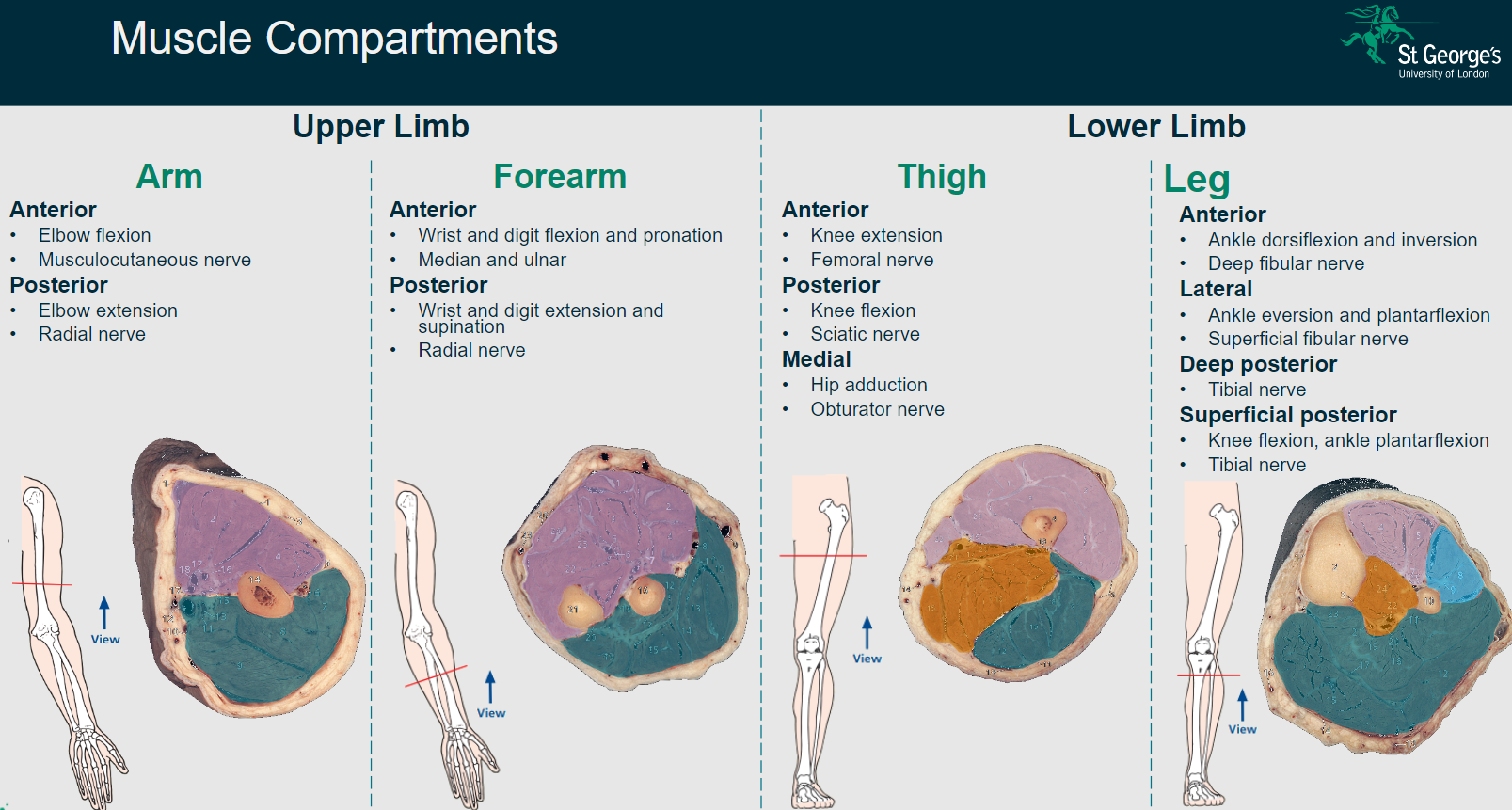
Wrist and digit extension and supination
Innervated by the radial nerve.
-
What are the actions and innervation of the anterior thigh? (2)
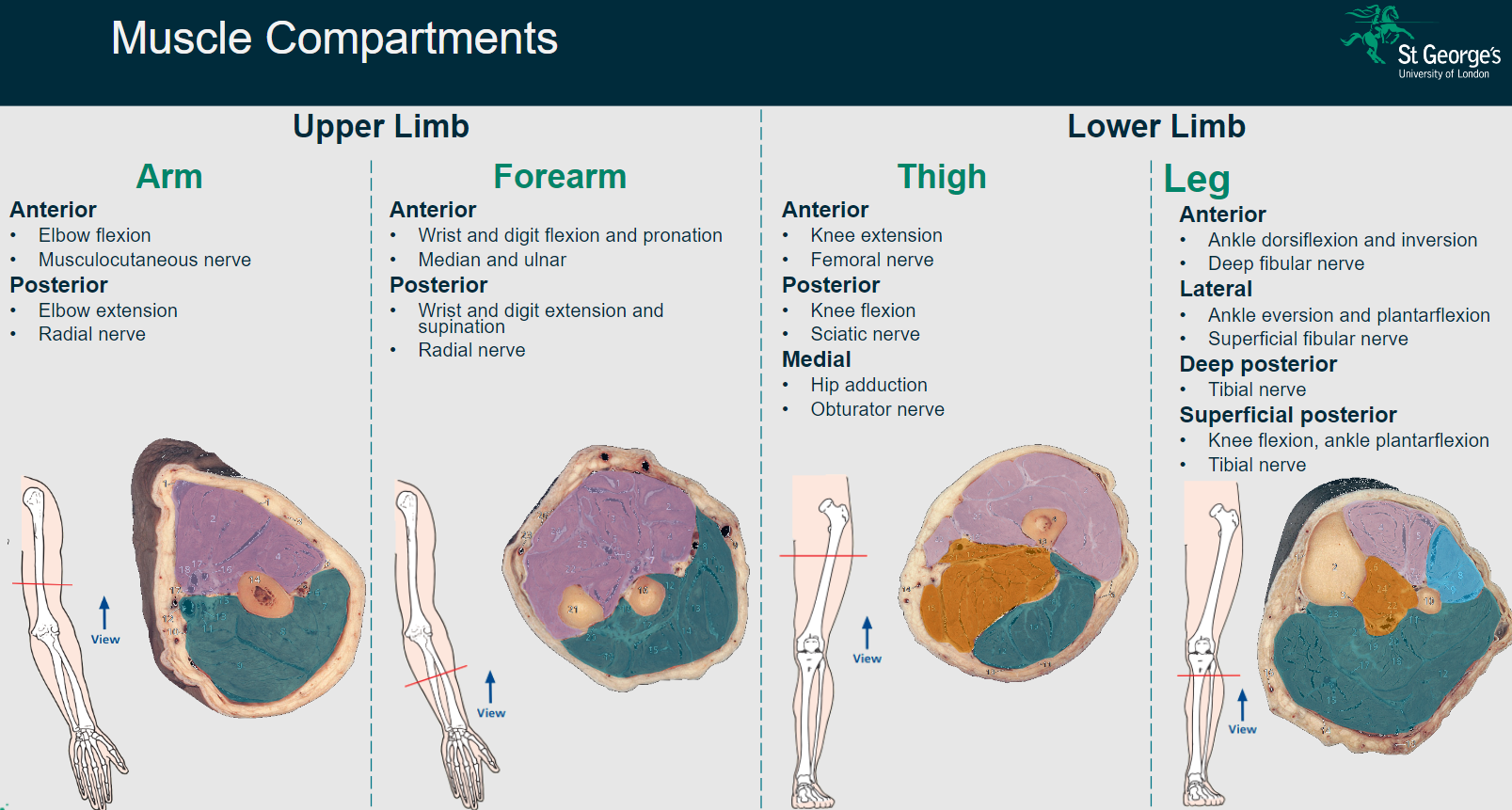
Knee extension
Innervated by the femoral nerve.
-
What are the actions and innervation of the posterior thigh? (2)
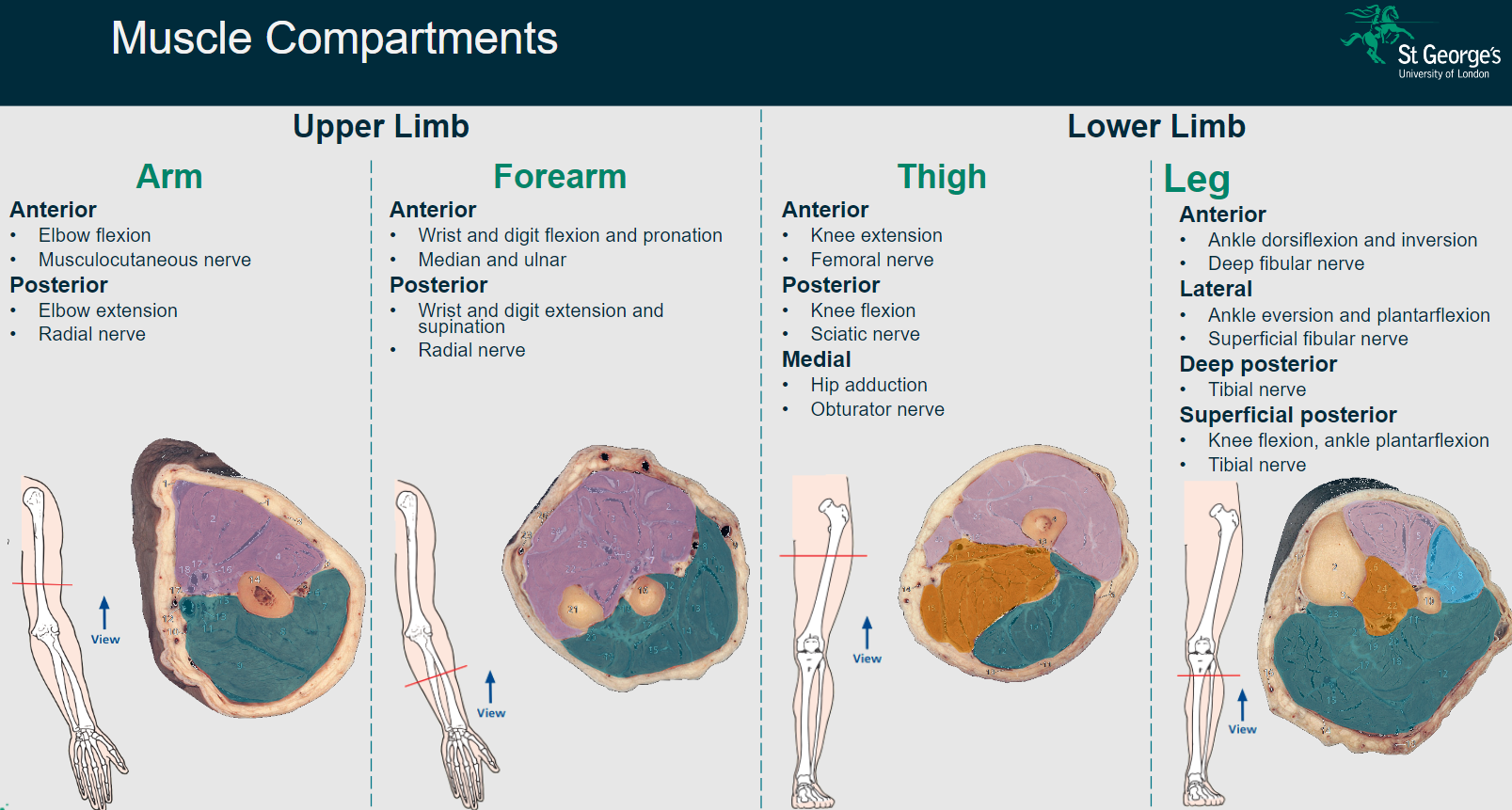
Knee flexion
Innervated by the sciatic nerve.
-
What are the actions and innervation of the medial thigh? (2)
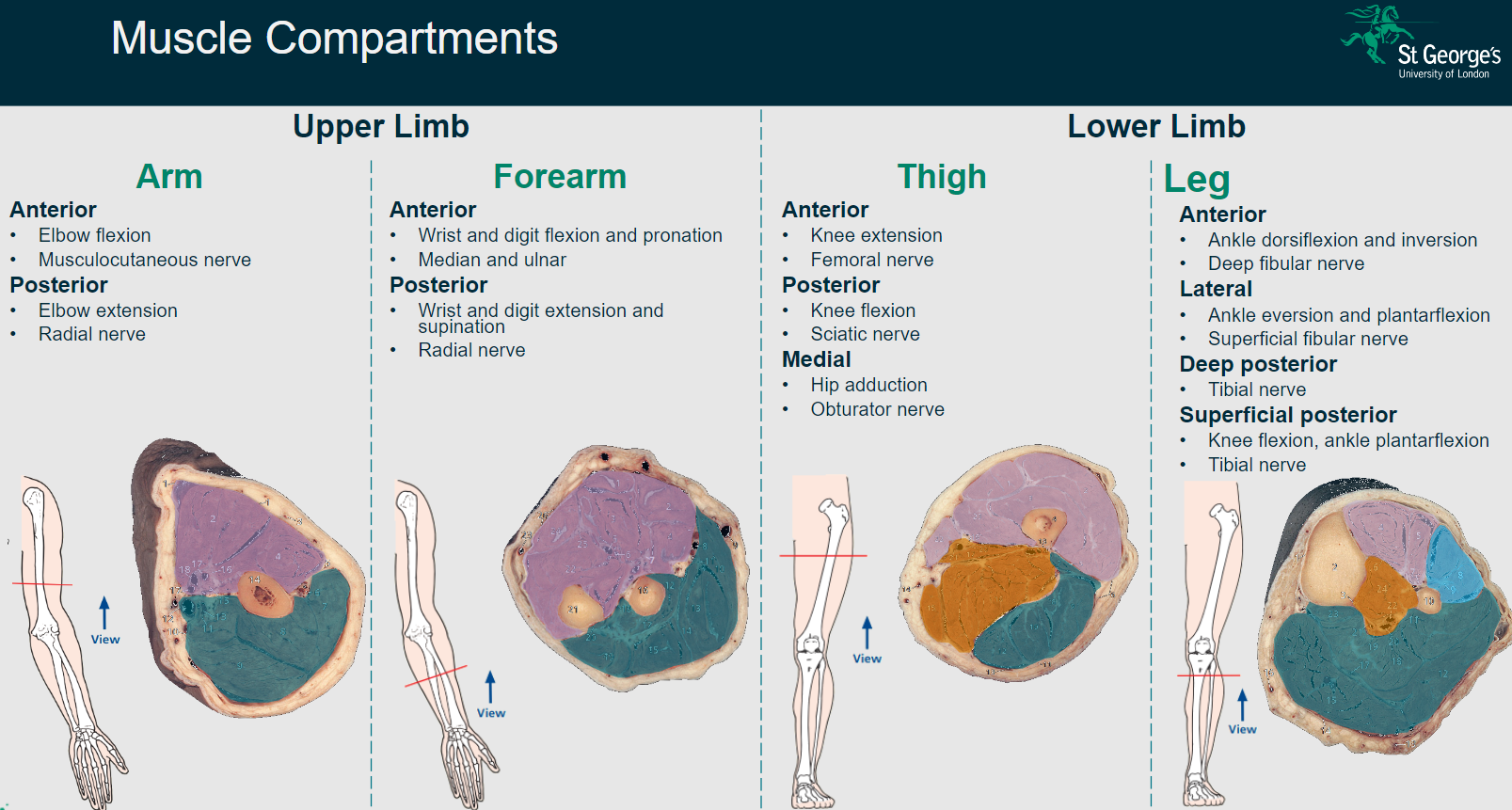
Hip adduction
Innervated by the obturator nerve.
-
What type of connective tissue makes up tendons? (1)
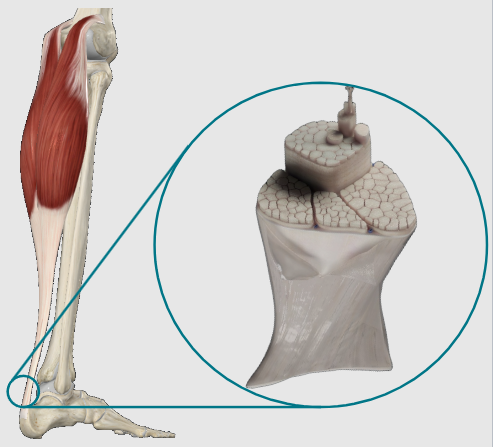
Dense connective tissue.
-
What type of collagen is predominantly found in tendons, and what is its characteristic? (2)

Type 1 collagen.
Provides high tensile strength.
-
What is the primary function of tendons? (3)
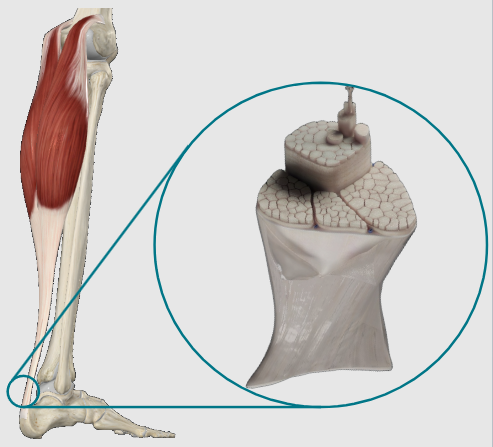
Transmits mechanical force of muscle to the bone.
Allows muscle bulk to be situated away from its site of action.
Enables muscles to pull "round corners."

